


“Tim, here in Uzbekistan, do you have any jokes about people from Turkmenistan?”
Our guide Timor thought about this deeply for a long moment.
“No. Not really. But we have Jew joke.”
Okay, moving right along!
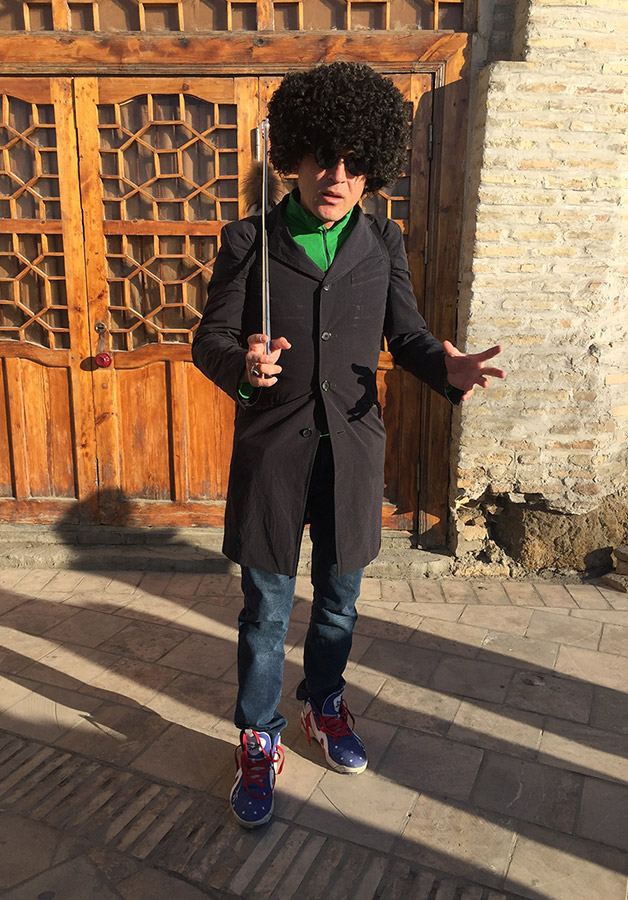
Our Uzbek guide Tim was amazing. I understood about 10% of what he was talking about at any given time.
“Okay, well, this land here is color of piss. Spring is migration time of the dogs. Tomorrow we will go to summer camp.”
I’m pretty sure he actually said “color of this,” “migration of storks,” and that we were headed to Samarkand. Regardless, the jokes about Summer Camp would not die after this.
One day, Timor explained Islam to us.
“The ram said ‘Wake up woman, you get your wish because you asked Allah very hard.’”
If only the whole world could have heard this, we’d have a lot fewer problems.
Another day, Tim explained Buddhism to us. This involved repeating thrice-removed misheard versions of a couple of famous moments from the Buddha’s life, leaving out the point that each story was meant to illustrate, and confusing even those of us who already knew the stories and what they meant.
“Buddha was prince who want to leave palace to find God, you know, so he sit under tree, you know famous tree as girl give him food or something, and he realize this philosophy of Buddhism.” (this quote has been edited for clarity)
Timor was absolutely terrible at explaining things and it was impossible to listen to him talk for more than twenty seconds without involuntarily tuning him out completely and I miss him so much.
On one of our last days in Uzbekistan, Tim showed up in surprisingly sedate clothing, sporting loafers and a windbreaker. Gone were his loud red, white and blue American flag sneakers. Gone was his immense Uzbek fur hat. Gone were his Ray Ban aviators tinted to match the color of his jogging suit.
Wow. What the F happened?
I realized we were in Timor’s home town.
“Timor, you’re dressed differently today!”
“Thank you my friend.”
“Did your wife make you change your outfit?”
“You are exactly right,” Tim answered, sadly.
The next day we were off on the road and Tim was dressed like Paulie Walnuts crossed with Dennis Rodman again. So good to have you back Timor.
We sat down to dinner and a local musician playing some kind of Uzbek banjo burst into the room and seemed to make a beeline straight for Amit at my table.
“Hello! You are Arab, Turkmen?” he asked enthusiastically.
“No, no, I am from India,” Amit answered, thinking for a brief moment that he was off the hook.
“AAAAAAH, India! Yes yes!” The dude scorched out a little Indian-style Uzbek banjo riff.
Then he launched into a long, noodly piece that was apparently the theme from some Bollywood movie from 40 years ago.
“Right, my friend? Eh? Eh?”
Amit nodded awkwardly.
I made a joke about the guy playing us all songs related to our home countries. I thought he might play “Cat Scratch Fever” for me, but I hoped it would actually be “Born in the U.S.A.” or even better, “I’m Proud to Be an American.” That song only gets better when you Uzbek banjo it.
Then the fucking guy came back out of nowhere and played another Indian song. Amit visibly paled and stared down at his empty plate.
The musician wandered away. Then promptly returned and farted out another Indian tune. I could visibly see Amit trying to die.
The song ended and I applauded loudly. “More Indian music!”
The banjo dude obliged.
Eventually Amit had to give him some Uzbek money just to fuck off. The whole thing was hilarious.
The banjo dude was followed up by Uzbekistan’s national institution, a crusty old comedian/magician whose act would have seemed stale at a children’s birthday party in 1940. This went on forever and was deeply painful.
The woman gestured for me to pay her before I ascended the unbelievably worn, twisted wooden stairs leading up into the tower.
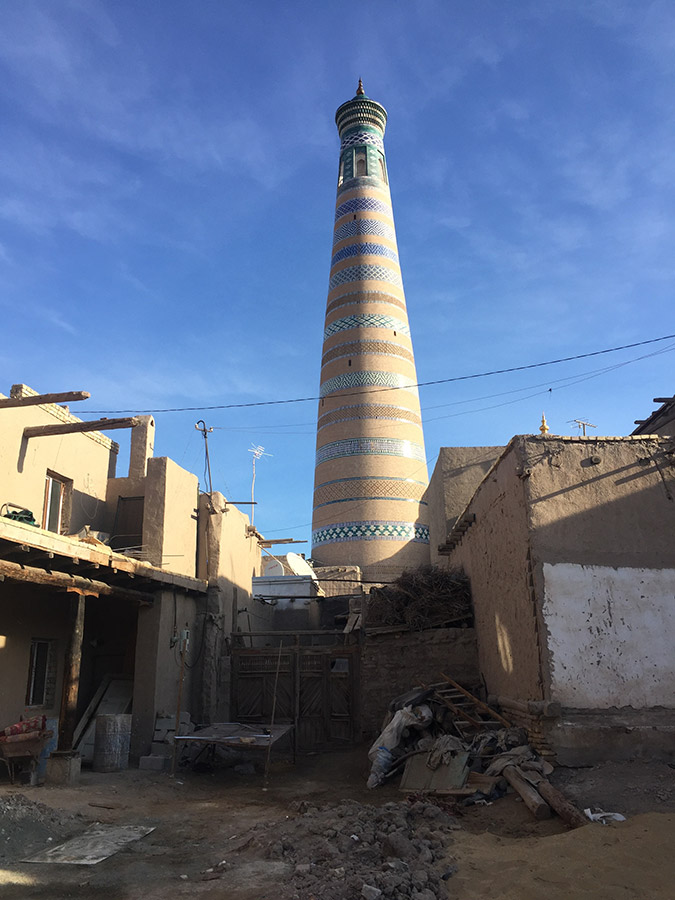
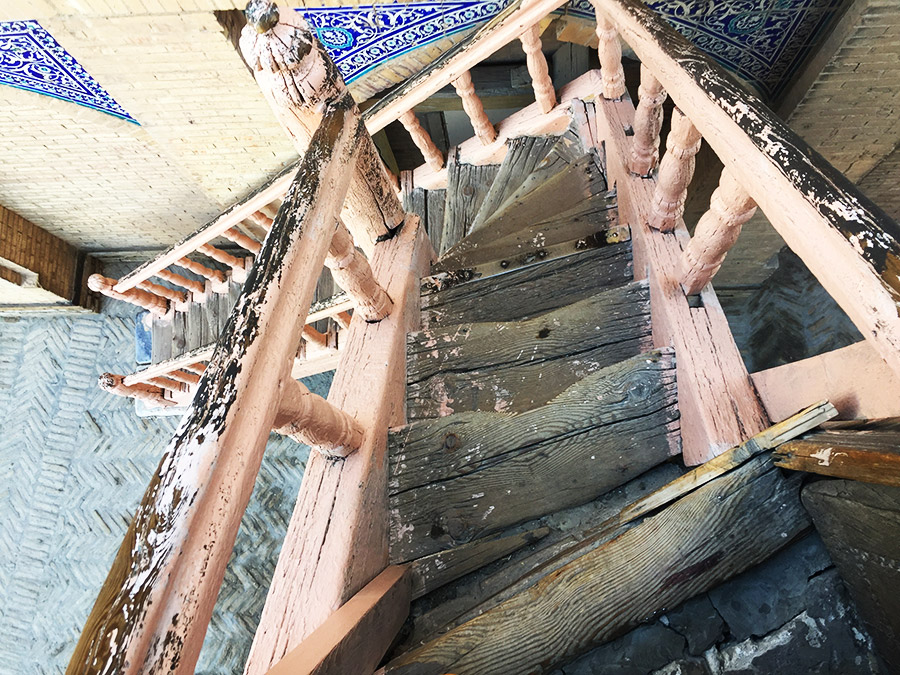
Inside, it was pitch black. I took out my phone and turned on the flashlight app. I held the phone awkwardly as I climbed on my hands and feet up the twisting spiral staircase, the ceiling too low for me to stand and my shoulders brushing against the stone walls on either side of me.
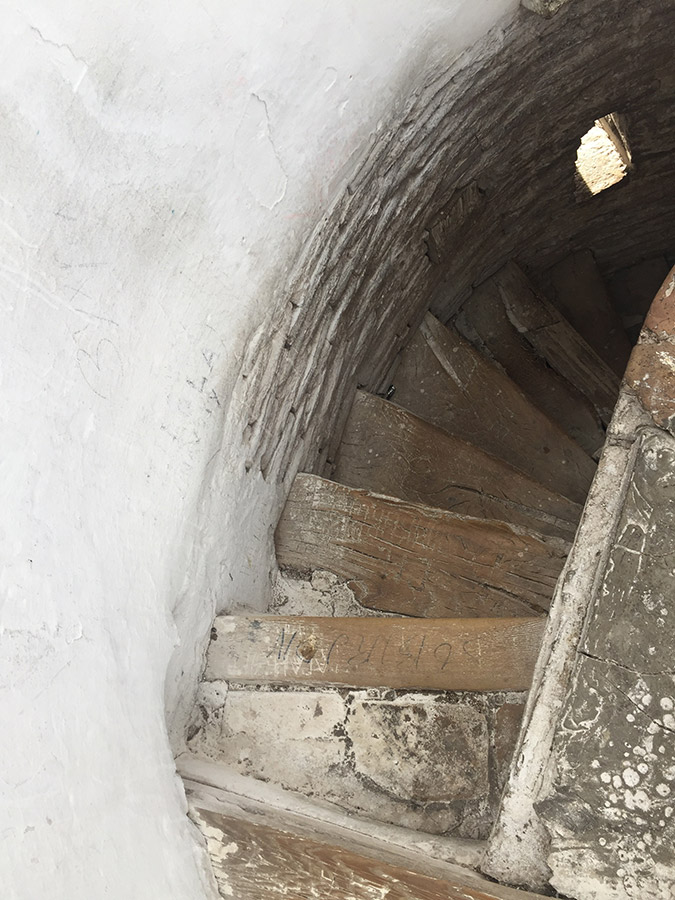
This has definitely been designed to kill claustrophobics.
I climbed up and up in a continual left-hand turn, the light bobbing up and down, illuminating the curved wall above me and then the wooden steps below every time I gripped a step and pulled myself up with the same hand that was holding my phone. My thighs would be brutally sore for days after the burn of climbing this long staircase in a continuous squat.
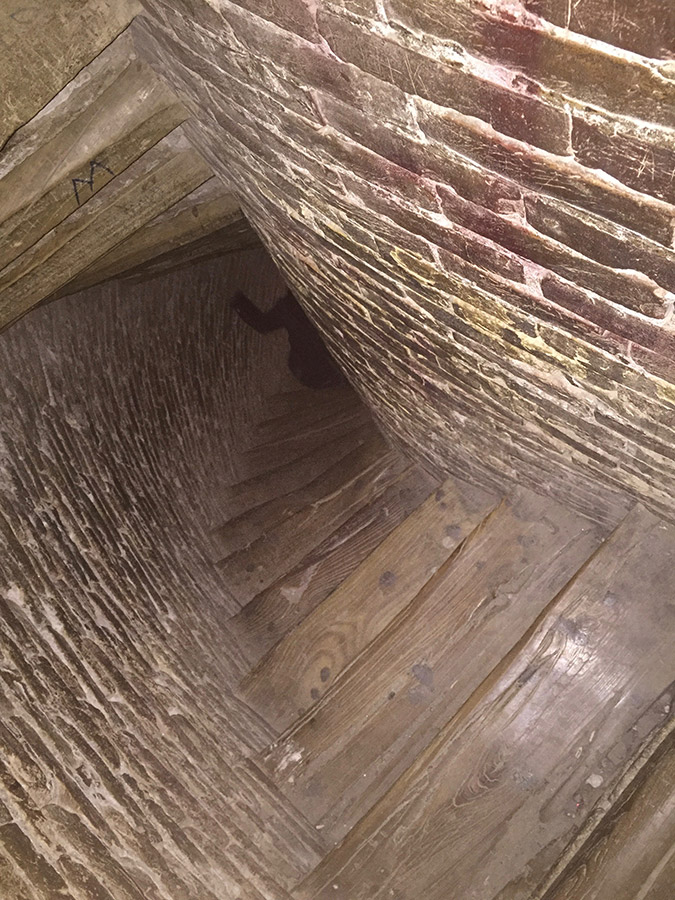
Halfway up the tower I ran into an elderly couple who were climbing down and I laughed out loud. This is the absolute worst situation in which I have ever encountered the need for two-way traffic. After a brief pause while we all realized there was no other way out of this, I pushed my body against the outer wall of the staircase, bending my head and shoulders sideways against the ceiling like an upside-down letter L. I sucked in my everything. The elderly Uzbek couple, waiting for no invitation, pressed against the inner wall of the stairwell and squeezed slowly past me, our clothes audibly rubbing together. Good one, Uzbekistan.
At the top of the tower, the ancient walled city of Khiva spread out before me in the morning light.
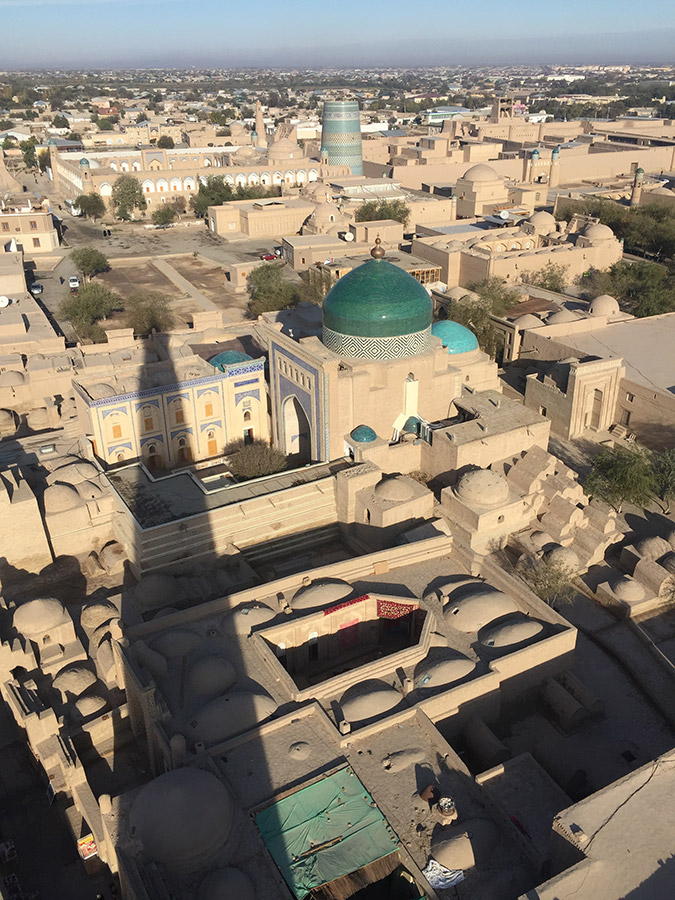
Two Uzbek women emerged out of the stair hole and engaged me in a lengthy conversation, notable mostly for the fact that I don’t speak a word of Uzbek. This hindered them not in telling me all about their day, or nuclear physics, or whatever they were talking about.
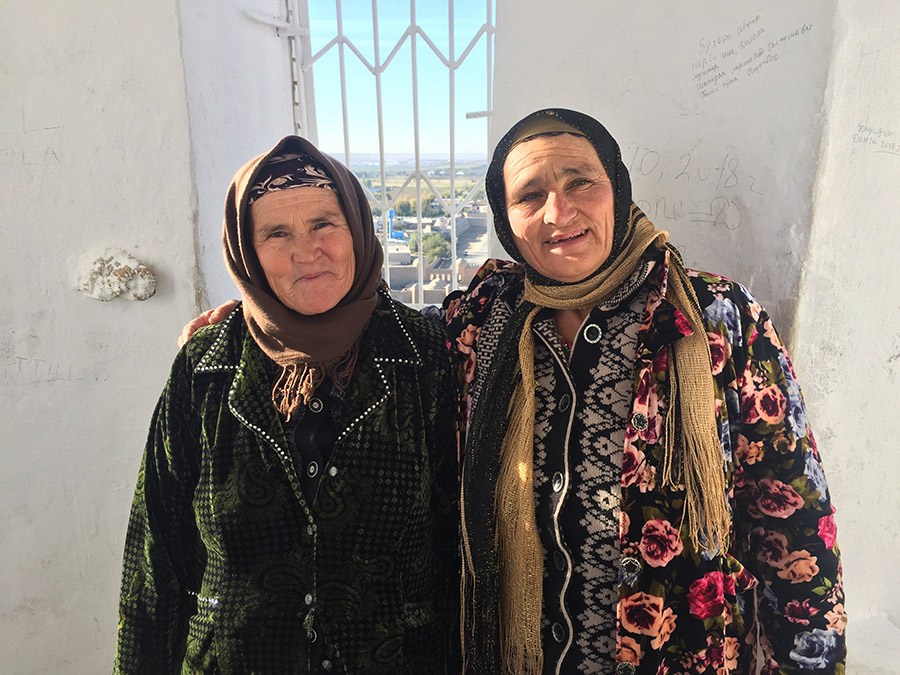
They were followed out of the hole by a British brother and sister who wanted to know everything about my time in Turkmenistan. I think the sister was mostly delaying the inevitable descent back down the stair hole.
My friends Pete and Kinga were next out of the hole. It’s a regular party up here.
I looked out across Khiva at the smaller Djuma minaret, which I had climbed right as it was closing the evening before.
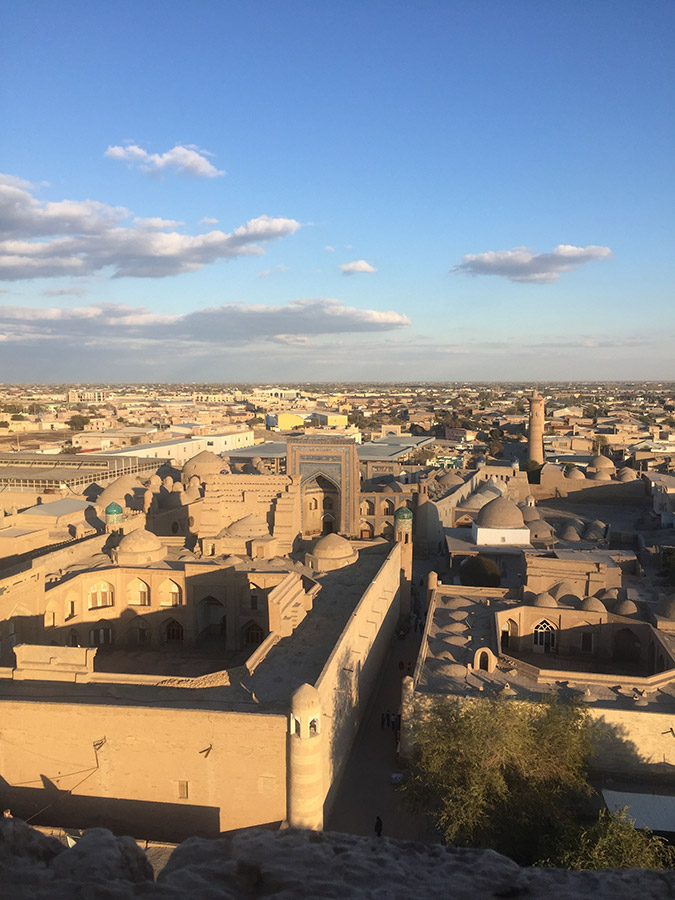
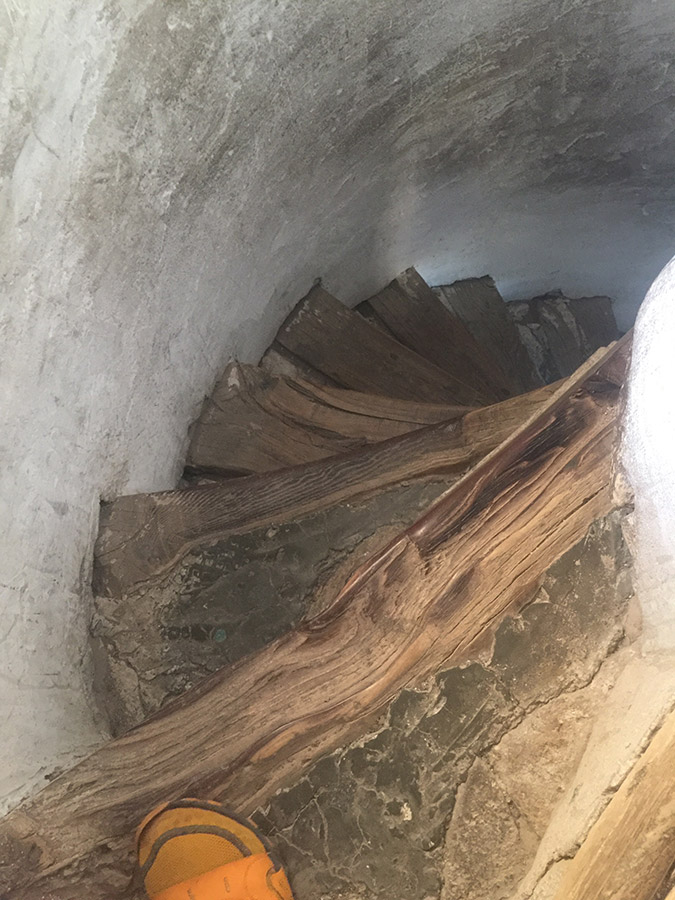
Beyond that sat the west wall of the city, which our guide Timor had led us up the previous evening to view the sunset, a remarkable choice given that it’s the only place in the city where you can’t see the sun set.
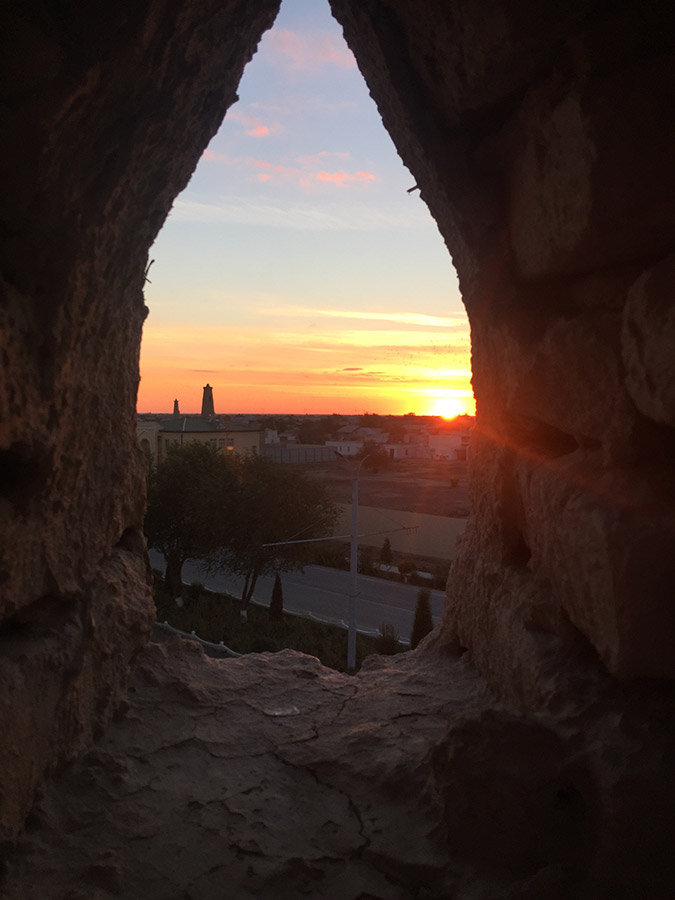
I’d managed to find a hole in the wall that was both pointing in the right direction and big enough to fit my head into, and watched in reverie as hundreds of thousands of black birds flew into the sunset in an otherworldly parade.
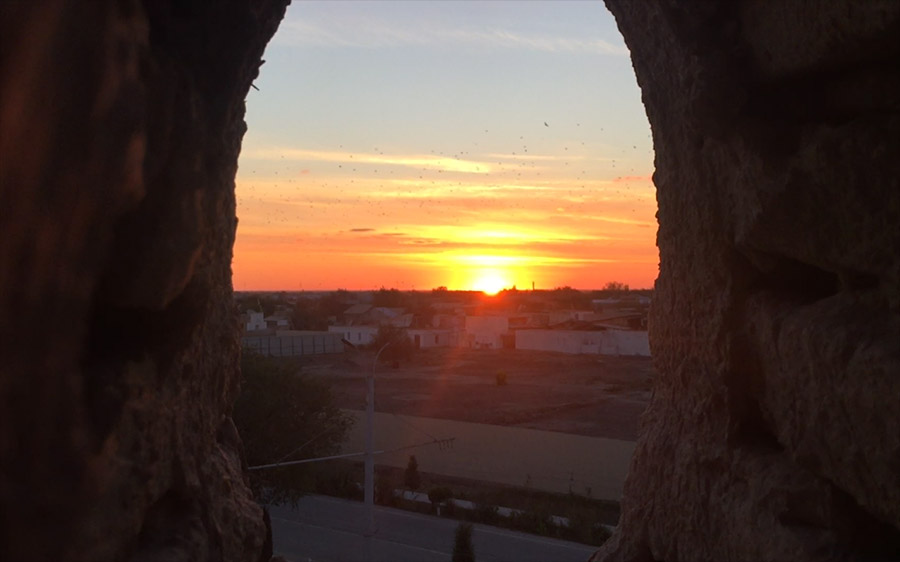
Whatever the cause, these birds are doing fantastically well in Central Asia. An evening drive through the city is often accompanied by an eerie rolling boil of millions of bird sounds that seem to melt the very air all around you.
I reflected on how different Uzbekistan felt compared to Turkmenistan. The people seemed far friendlier and happier. Everyone in Turkmenistan seemed more suspicious and afraid. Even the sun seemed to be shining differently in Uzbekistan.
Not that it was a paradise of freedom. The U.S. was using Uzbekistan as a base of operations while invading Afghanistan after 9/11, but had to back out of the agreement after it turned out that Uzbekistan’s president was boiling people alive. You know you’ve pulled off something impressively heinous when the U.S. military decides they can’t be friends with you any more.
I looked down across the town, scanning for the concubines’ courtyard. There it is. I need to give this tile art one more look before we leave.
The previous afternoon we’d ventured into the part of the town where the Khan housed his wives on one side of a courtyard and his concubines on the other. The walls of the courtyard were packed with mind-blowingly intricate tile art.
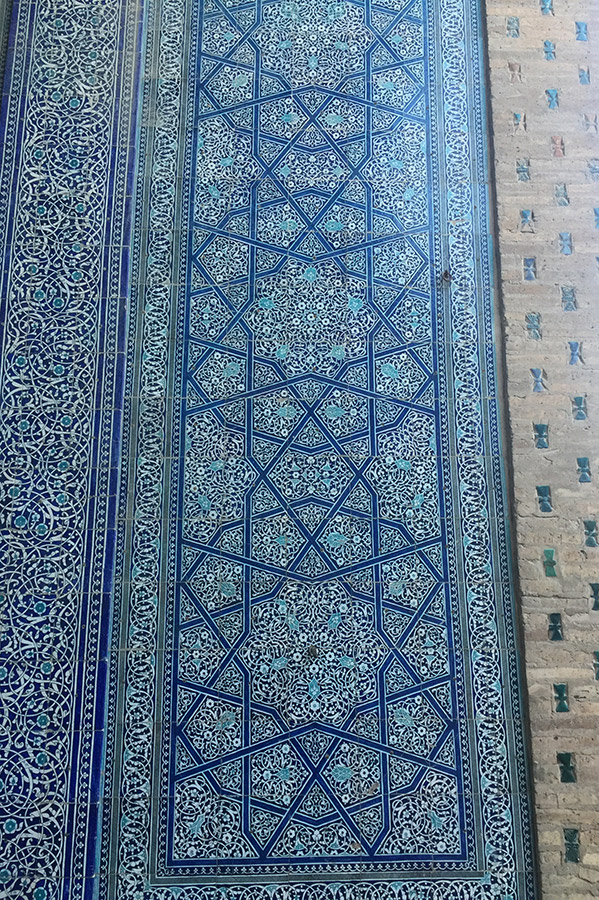
Staring at the complex designs in the tile, I felt my consciousness shift upwards into a higher dimension. Huh. This isn’t just decoration, there are sacred geometry concepts embedded in these designs. I stopped trying to analyze the patterns intellectually and let my mind go. The lines curved around, implying flowing water, and weaved into thickets of increasingly complex designs. Aspects of the patterns emerged in new planes of three-dimensional depth as I peered into them and my head began to buzz. Huh.
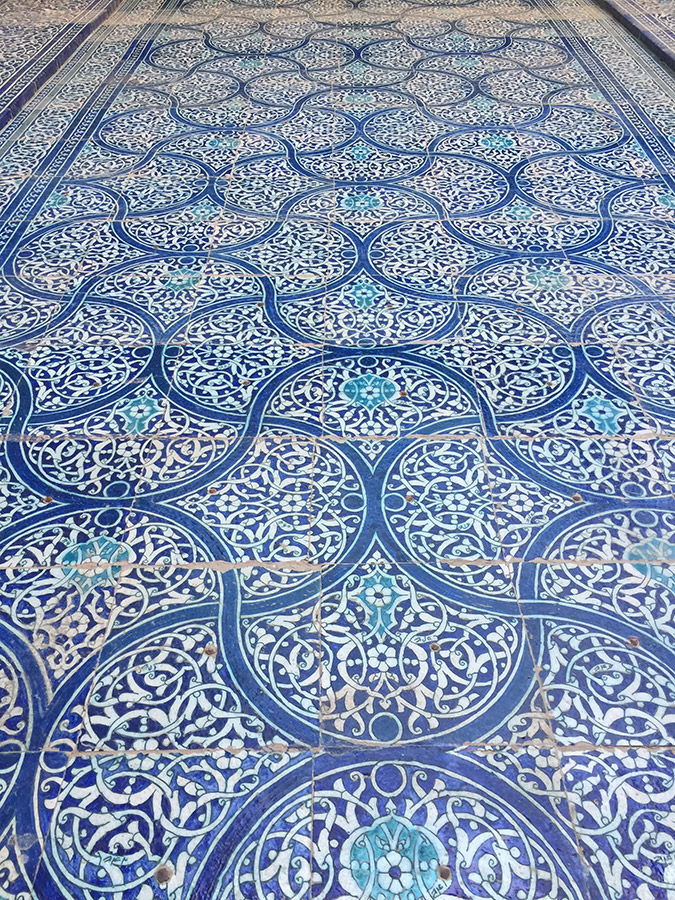
I gradually became aware that looking deeply into these designs was intended to open up new levels of awareness, unlocking new pathways for consciousness. I soaked up as much of this as I could. Is this an activation I was drawn here to experience? When I closed my eyes, I felt as if I was moving horizontally through the designs. The buzzing in my head filled the air all around me and I tried to go as deeply into the patterns as I could without falling completely out of reality and leaving my body and/or hitting my head on the floor.
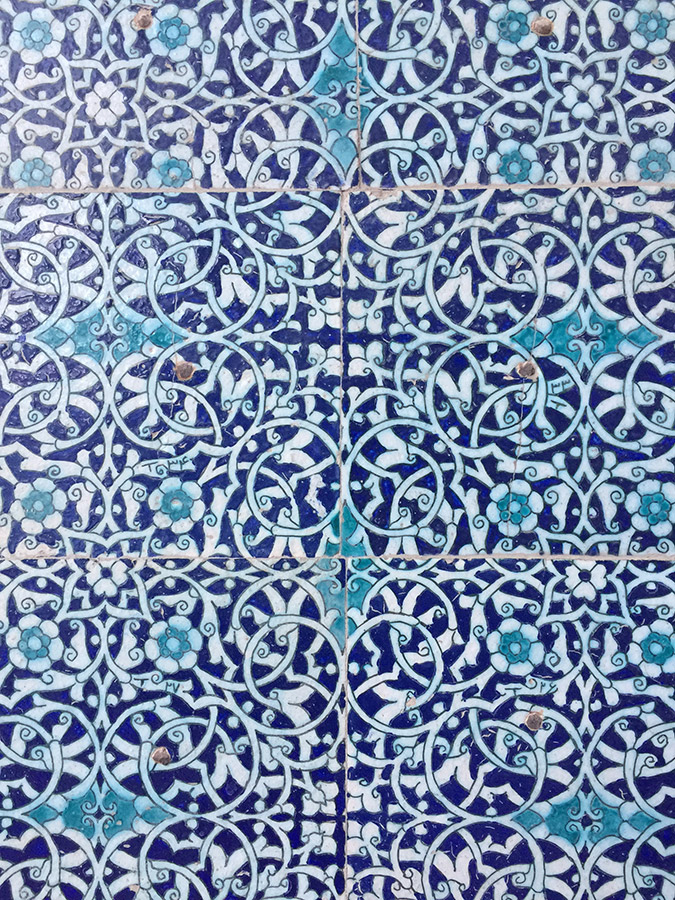
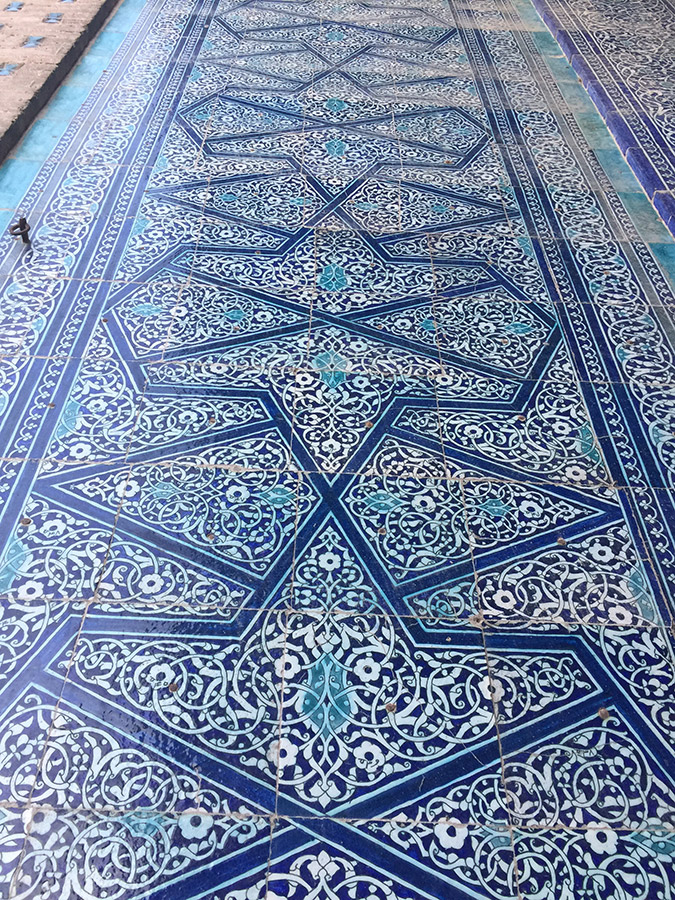
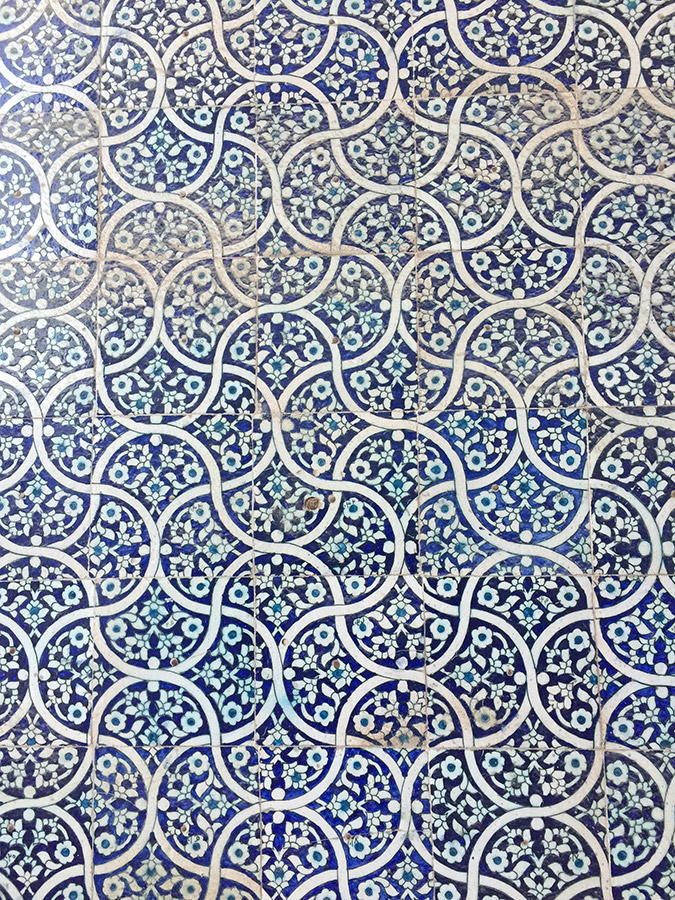
“What have you got into? You’re covered in dust,” Francine asked as I climbed onto the bus in a daze.
Jesus Christ, I look like Indiana Jones.
“I went up the tower. People were smaller back then.”
In the ancient historical city of Bukhara, we saw Uzbekistan’s monument to chess...
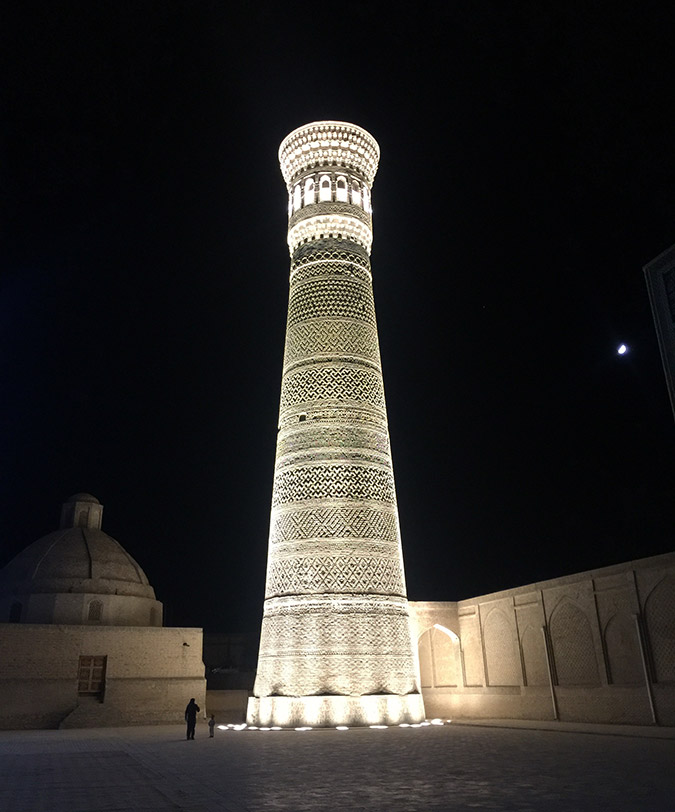
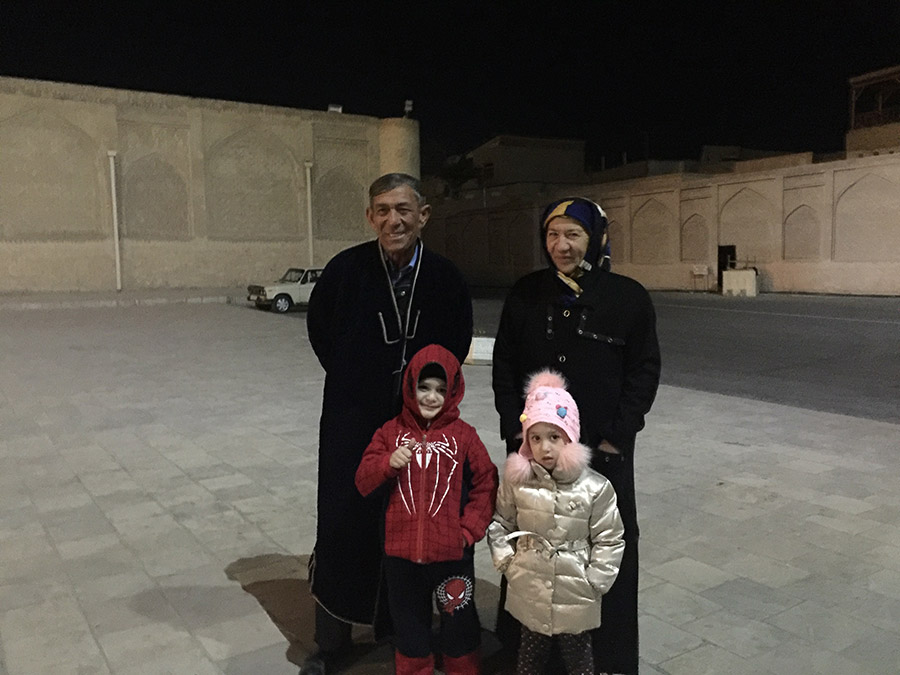
...Uzkbekistan’s monument to camels...
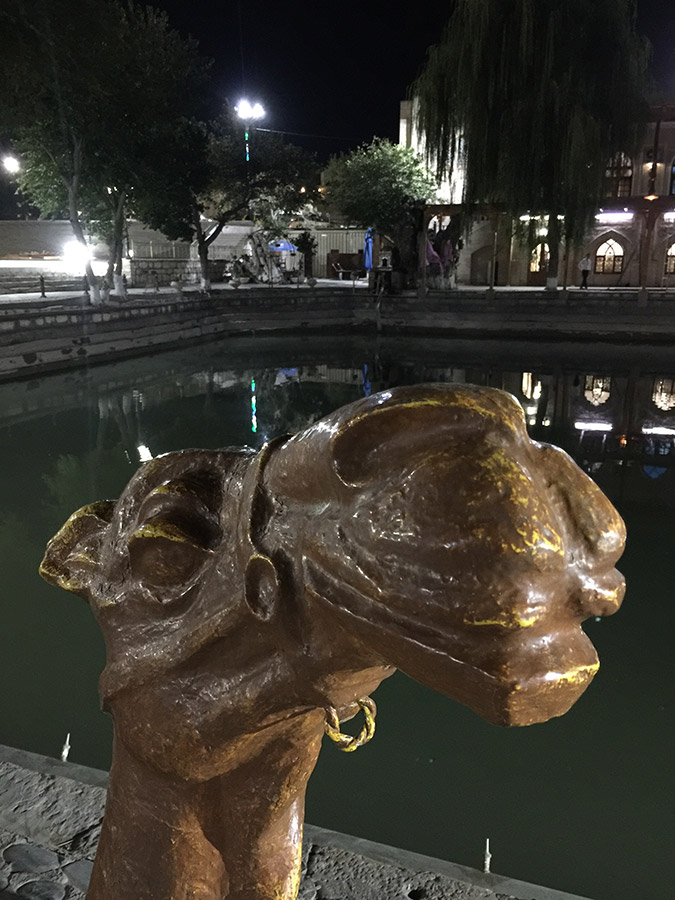
...and Uzbekistan’s monument to- wait, that’s a baby.
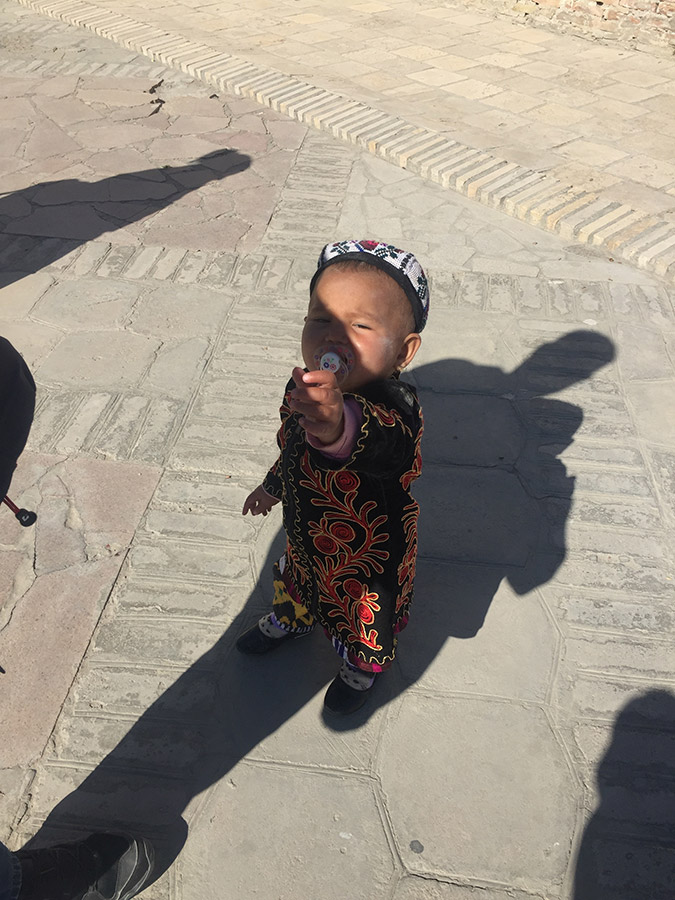
Francine and I braved certain death crossing an absurdly busy street to scour a friendly bazaar for the Ecuadoran bananas that were keeping me alive.
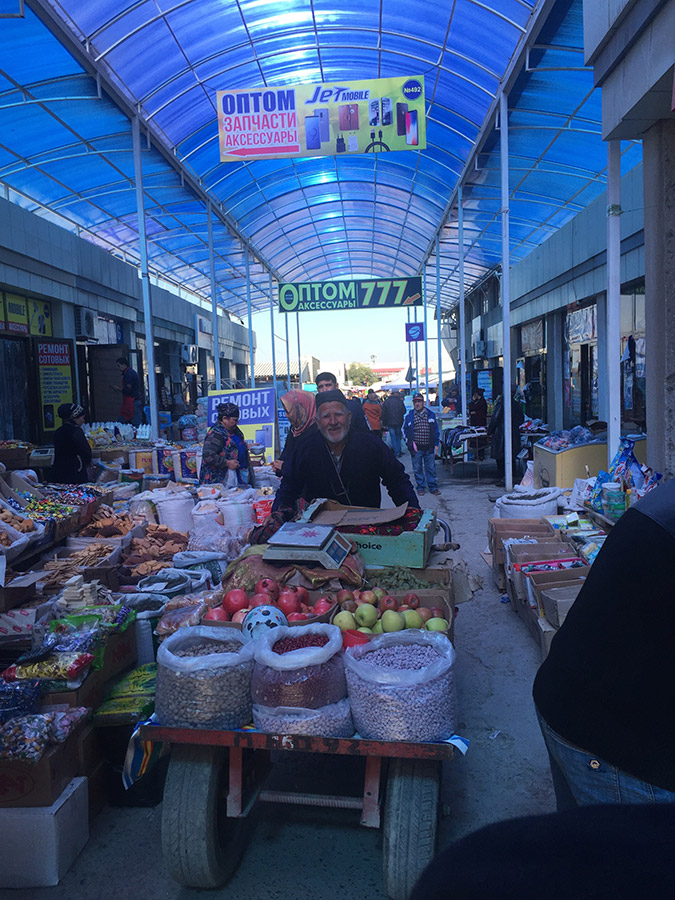

As we wandered through the streets of Bukhara, the strains of a familiar song echoed across the stone walkways.
”No April rain… No flowers bloom… No wedding Saturday within the month of June…”
Ah, it’s Uzbekistan’s national anthem. I Just Called to Say I Love You. This song had followed us all through the country. It was playing in the public square. It was playing on the bus. It was playing in the public square in an entirely different city. Uzbekistan seriously cannot get enough of Stevie Wonder’s 1984 hit. God bless those weirdos.
Timor led us up a ramp into the fortress. We ended up in a museum room that featured several artifacts from Uzbekistan’s past locked in glass cases. I checked everything out with the usual semi-detached tourist interest, my enthusiasm dimmed somewhat by the fact that finding vegan food in Uzbekistan was turning out to be a Quixotic quest, one paved in chicken broth, cream soups and egg glaze, which saw me eating an inhumane quantity of white rice that had left me nutritionally deficient in everything.
Suddenly I stopped in front of a glass case that had a strange outfit in it. What is this?
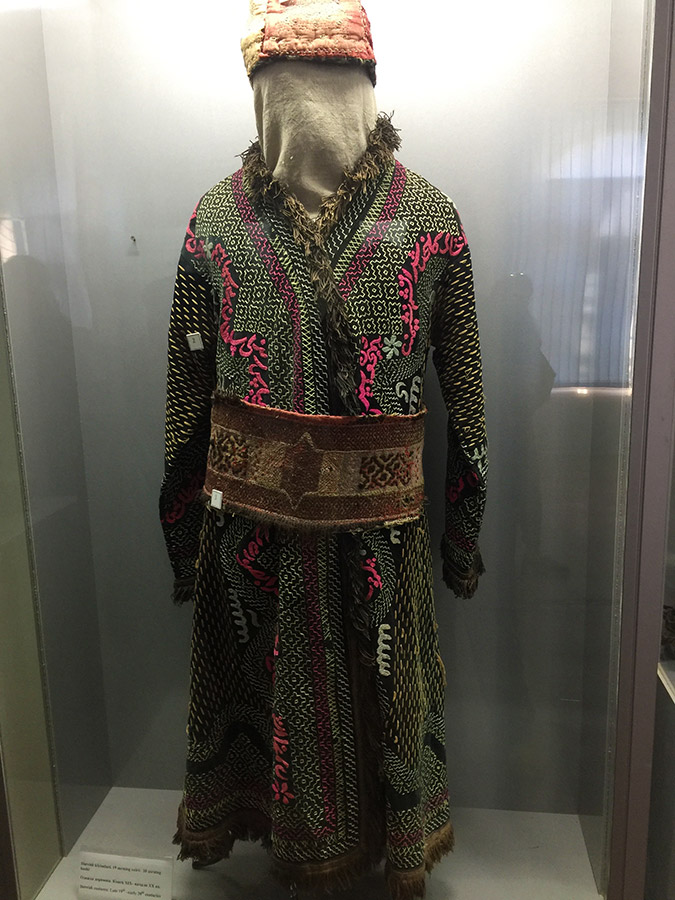
This seems weirdly familiar to me. Tim, what is this?
Timor explained that it was the outfit of a Dervish, a traveling Sufi monk. I looked at the weird knobby stick in the case. “They used these to climb up in the mountains.”
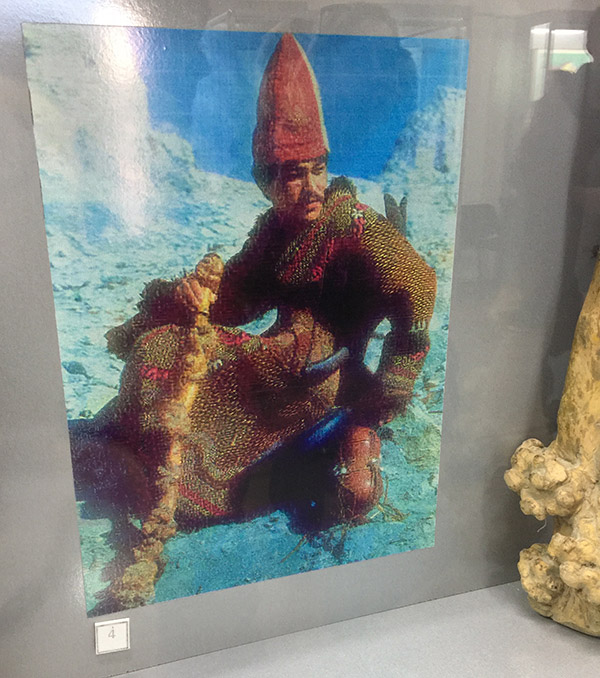
Shit. This seems really familiar. I think… I think I might have been one of these guys in a past life? This wasn’t something I had ever considered before, as I didn’t know shit about dervishes. Is this why I came to Central Asia twice this year? Is this why I used to go to a Sufi meditation group with my Iranian co-worker?
My whole body tingled. I asked my presence if I’d had a past life as one of these monks, could the consciousness I’d attained in that life be brought forward into this one? As soon as I asked this, my awareness shifted into a higher dimension and my sense of my body morphed from its usual shape into some kind of odd geometric form. I spent the rest of the day with my energy buzzing and a strange vague cloud of awareness swirling around me.
Huh. Well okay then.
I was feeling like I kept finding amazing things on this trip that weren’t really on the itinerary and that nobody else seemed to give a shit about at all. One of my favorites was the Bolo Haouz mosque, a building fronted by weathered wooden pillars that inside featured a deeply trippy white ceiling consisting of countless layers of origami-like geometric patterns that seemed to mimic mountain ranges one minute and stars in the night sky the next. Photos don’t really do this justice at all, but the effect in person of all these overlapping and interlocking planes of depth was both mesmerizing and transporting.
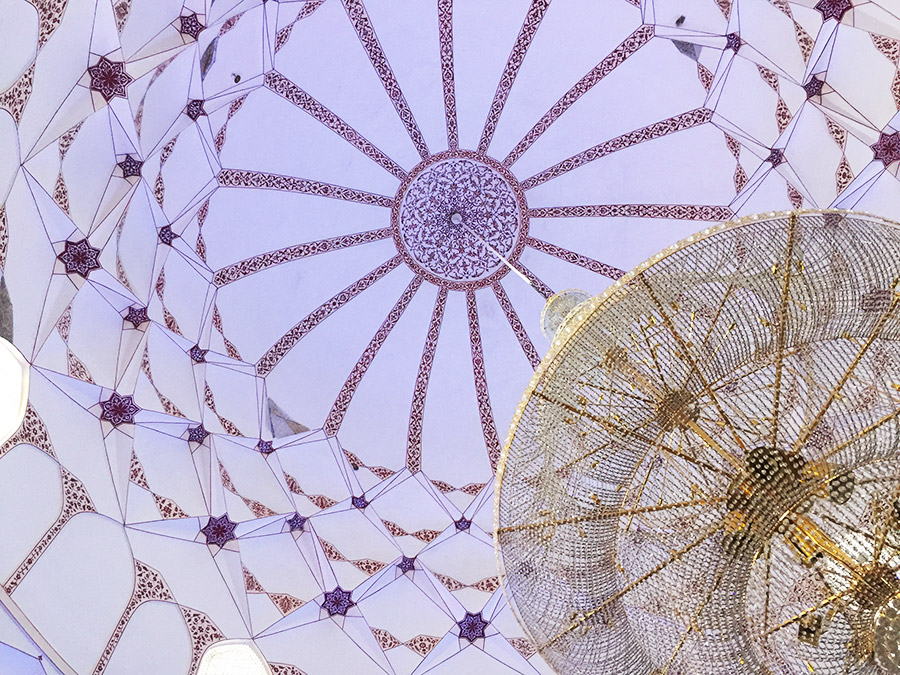
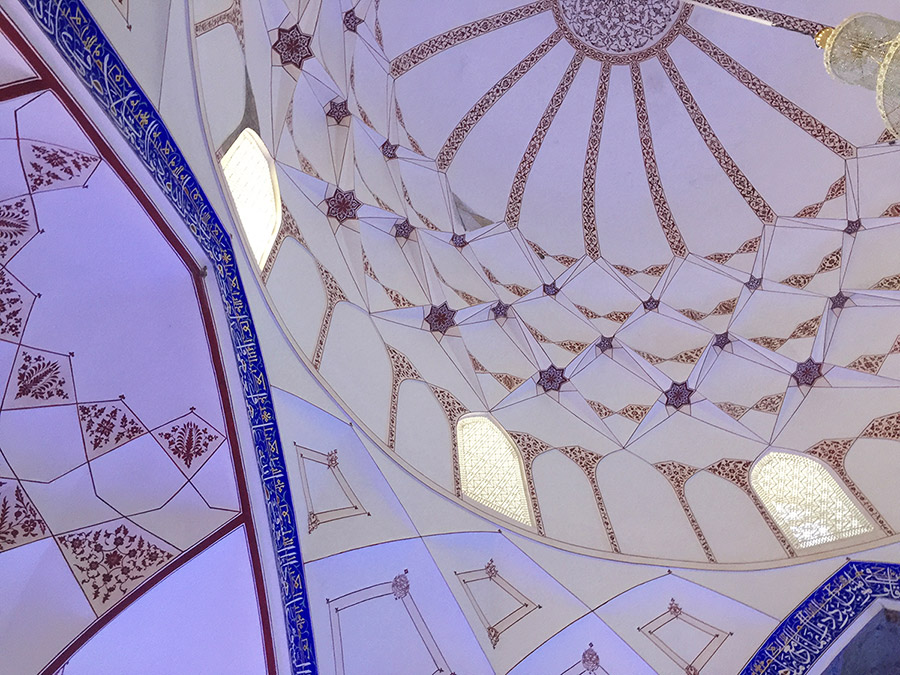
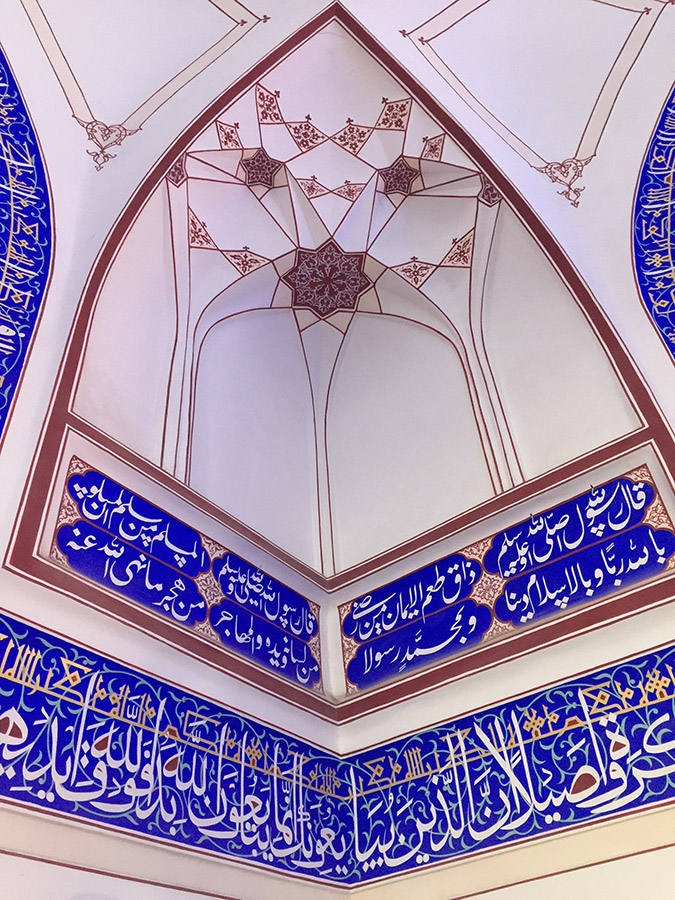
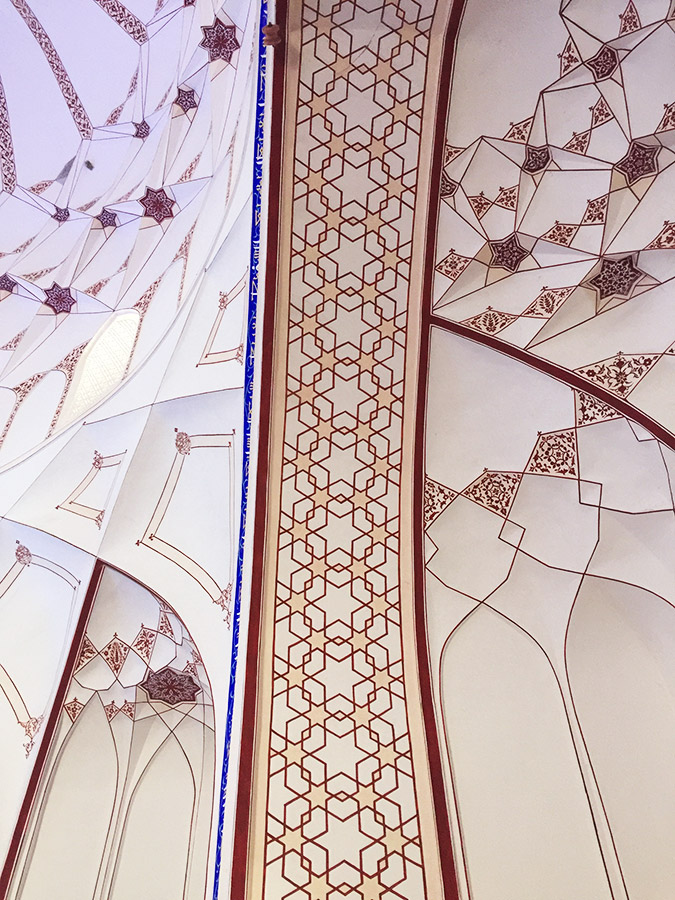
“Wait!” Bukhara chased after us on our way out of town. “You haven’t interacted with any unlicensed Disney characters at a simultaneously depressing and cheerfully bizarre children’s funfair!”
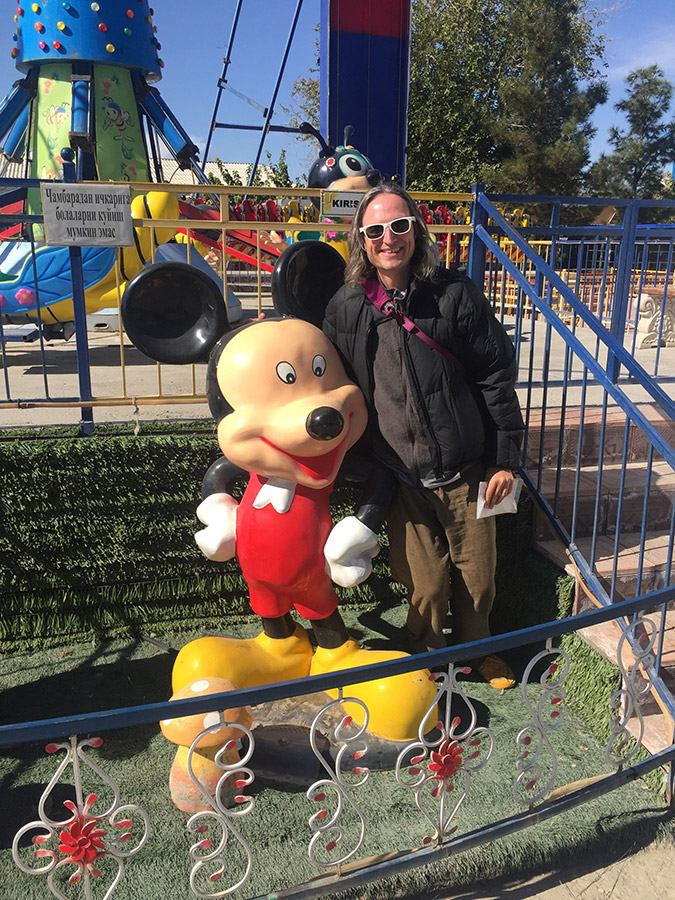
Remedied.
On a trip like this, you run the risk of becoming jaded after seeing so many beautiful buildings in a row. But in spite of this, Tamerlane’s mausoleum in Samarkand still managed to impress.
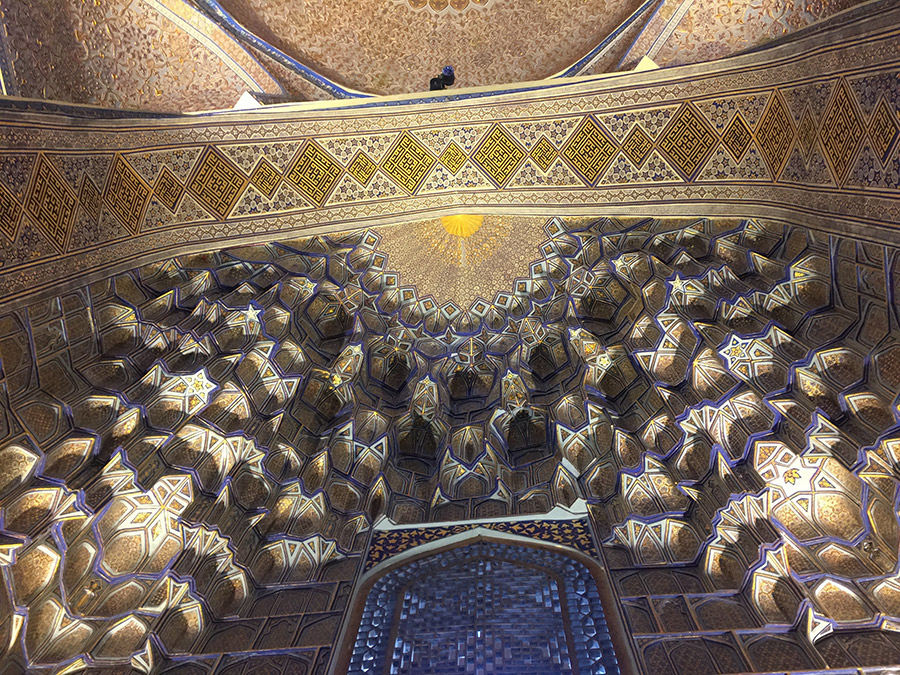
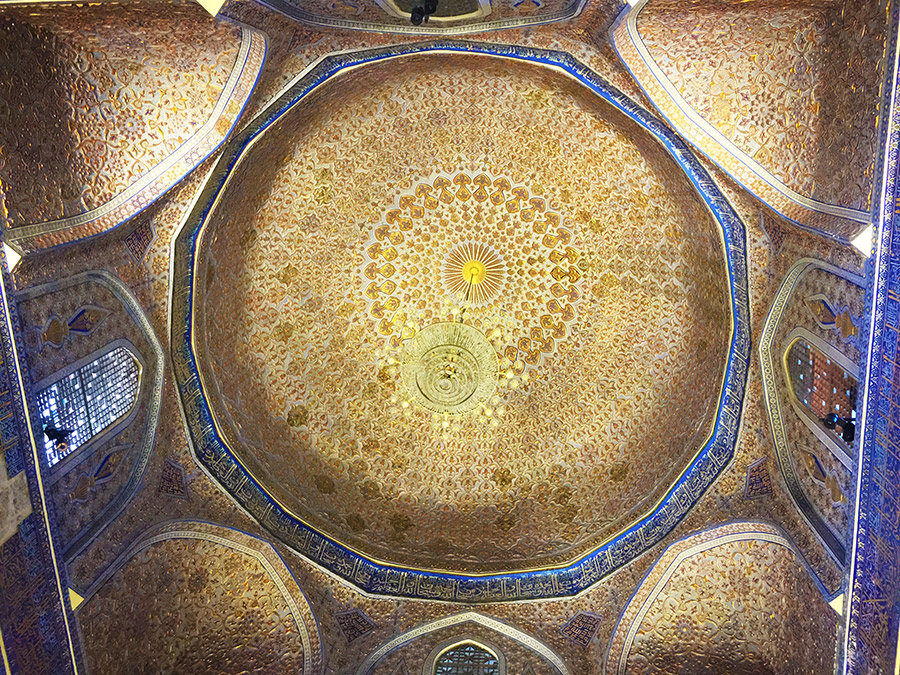
Although I think its actual function was completely lost on us, the Ulugh Beg observatory from the 1400s made for some impressive photos and the intriguing story of Tamerlane’s grandson, who just wanted to study the stars but was forced by birth into the role of a military leader, unto his untimely death.
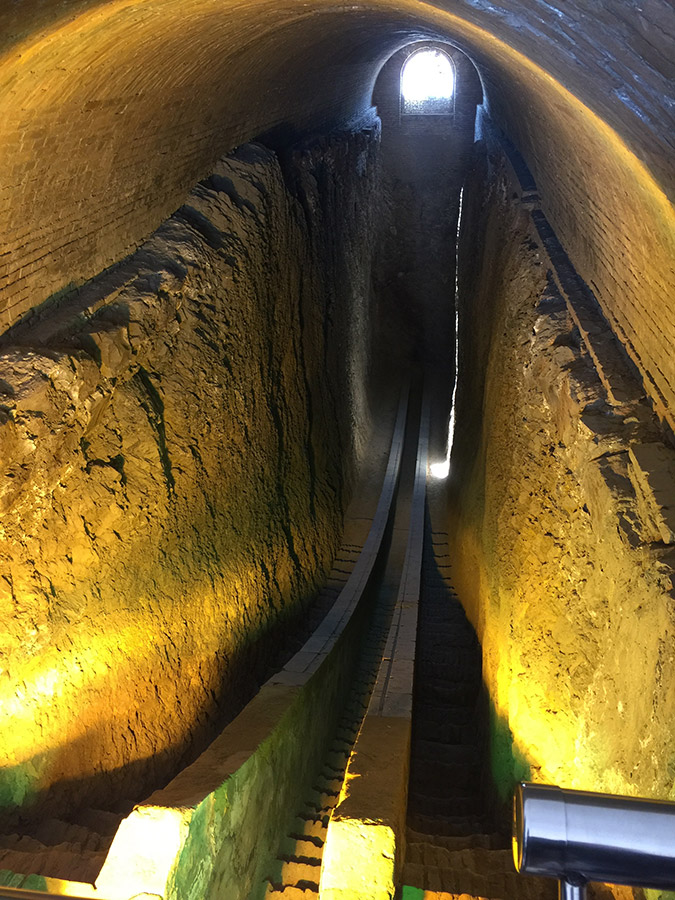
Registan Square offered up a smorgasbord of tourist delights. Want to blunder into a huge group of college students doing traditional dance in front of the madrassah, and then stand trapped in the background like a backup dancer until you can slip offstage unseen? Sure, we’ve got you covered. Want to walk around the courtyard and try to appreciate the tile art while a bunch of vendors hawk the same tourist crap at you over and over? No problem buddy.
Want to climb something really shaky and dangerous? Sean, we’ve been waiting for you.
I slipped the doorman a 20,000 so‘m bill and he opened the tiny, ancient door for me.
“Go down the hallway and take the stairs up. When you get to the top, don’t climb on the roof or you will die. Just stand up to your waist and you will be okay. Okay? Beautiful view. Have a nice day.”
What does that even mean? Guess I’m going to find out.
I wandered down the hallway, which grew shorter and shorter like an Alice in Wonderland gag until I was walking along bent forward at the waist, like I was exploring the 7 1/2th floor in Being John Malkovich. Eventually I reached the entrance to the stairwell, which curved steeply upward in the dark just like the minarets I had climbed in Khiva.
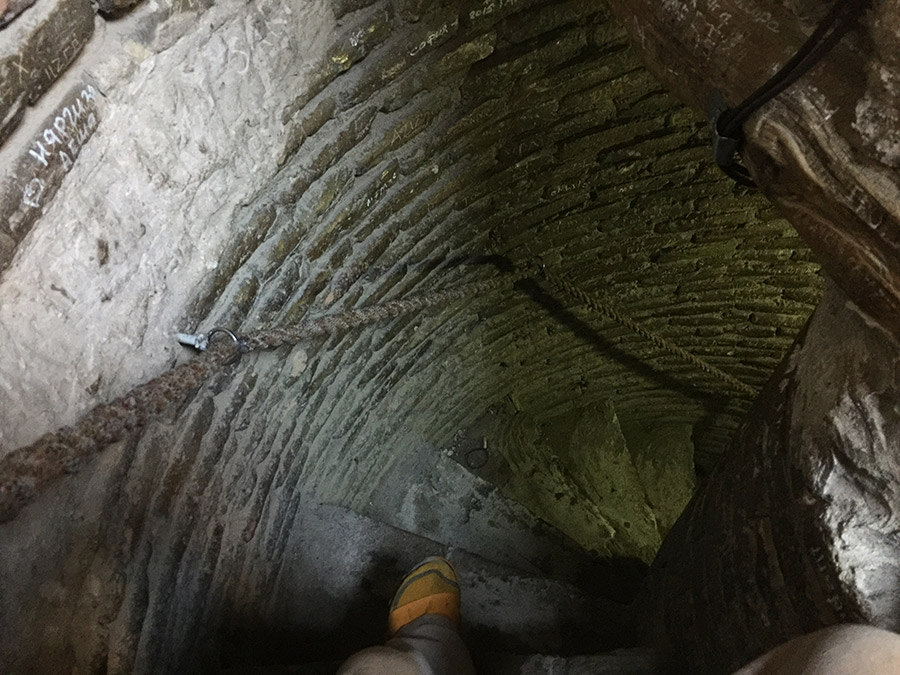
An entirely necessary rope helped you wrench yourself up the steps, as the ceiling was too low to even begin to stand up. I crawled upward in the dark, pausing at the occasional window to take in the slit of a view.
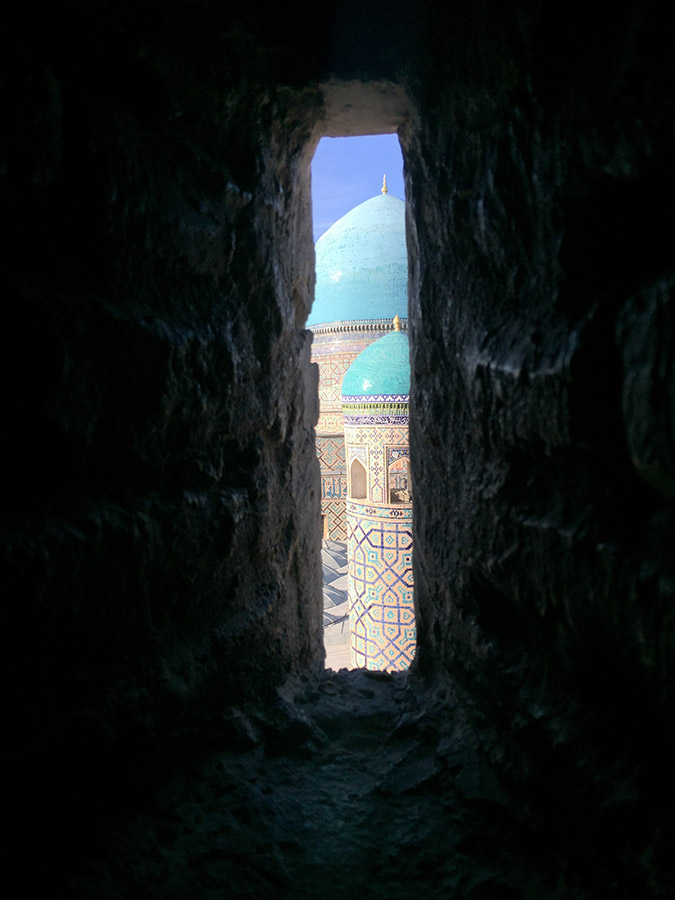
Eventually I reached the top of the tower, which was not what I was expecting at all. Rather than there being a viewing platform at the top, or a top floor, or a railing, or anything at all, the stairs just ran out at a hole that looked like it had been cut in the roof.
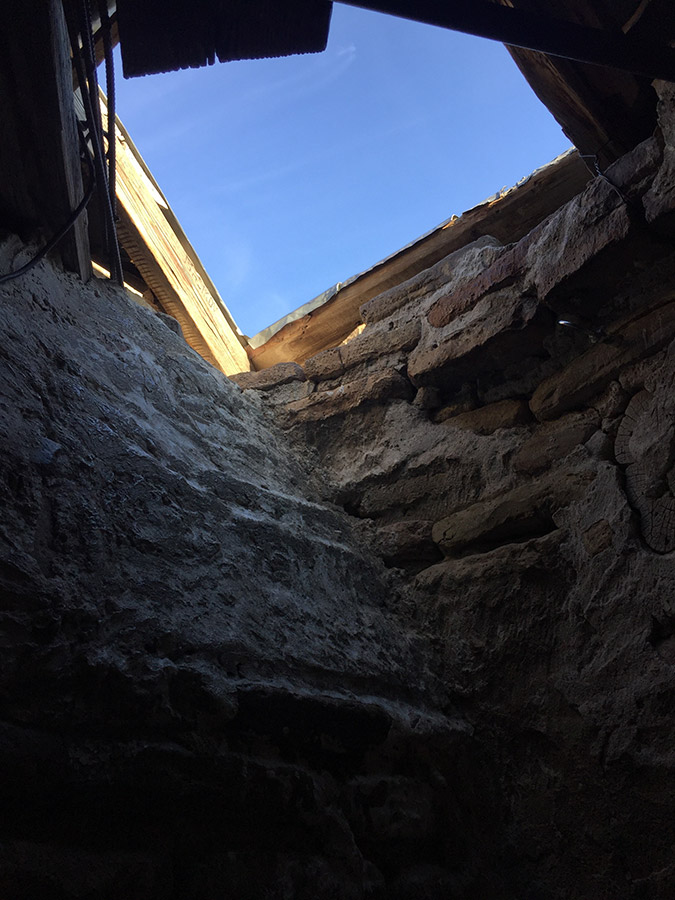
I poked my body up through the hole, and there I was, sticking out of the roof of this immense tower, like a cartoon character. Samarkand spread out around me in all directions.
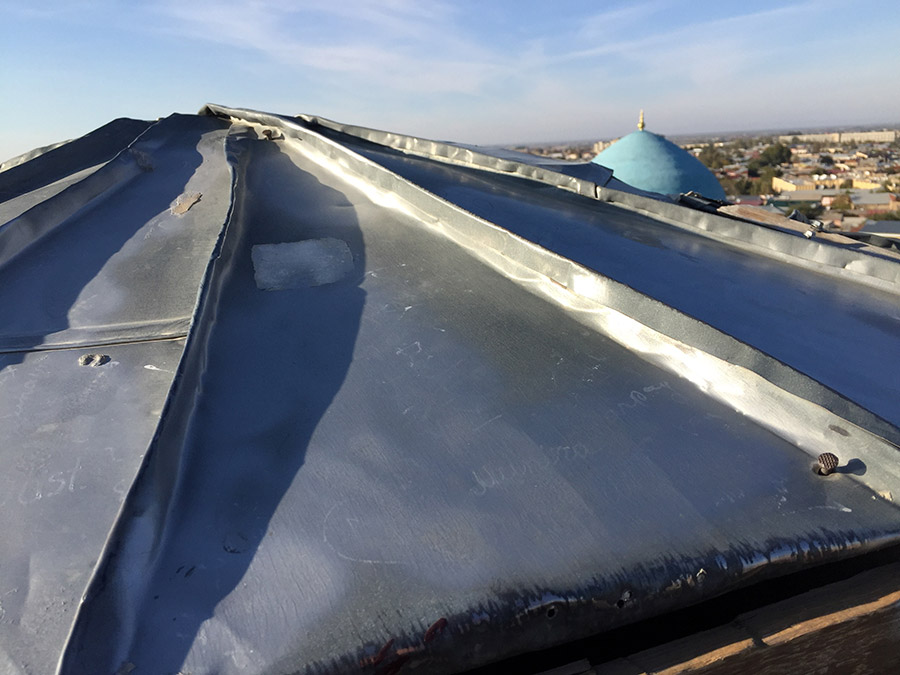
Being that high up, up in the wind and open air, with only my feet balancing on a sketchy wooden step and my knee pressing against the side of the roof opening keeping me from tipping over and plummeting to my death, was frankly kind of terrifying. But beautiful at the same time.
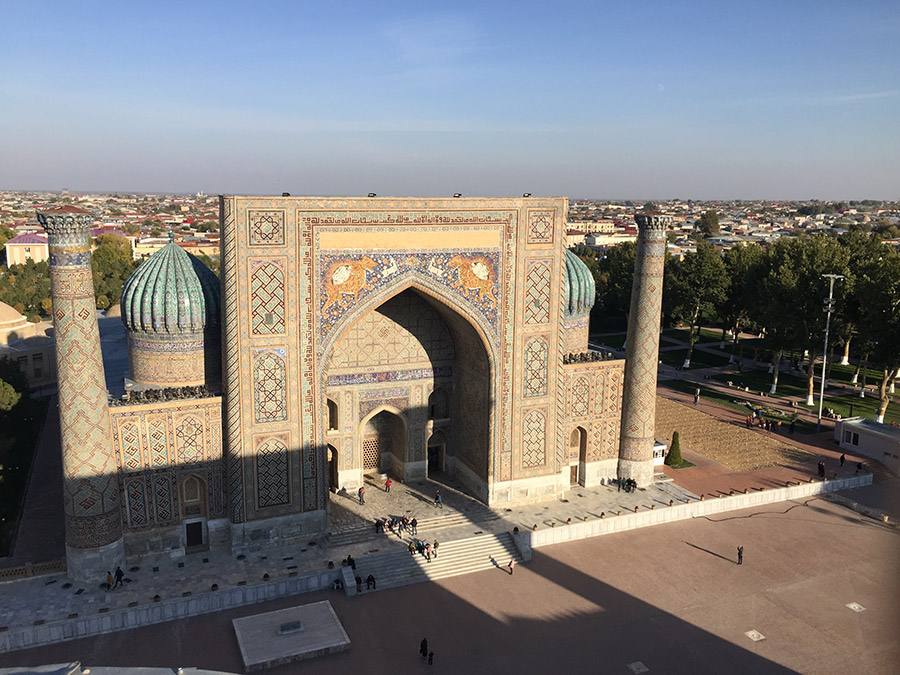
This is the kind of situation where you really wish you had some kind of wrist strap for your phone, since there are great photos in every direction, but you also kind of need one of your hands to frantically grab at the roof when the wind gusts.
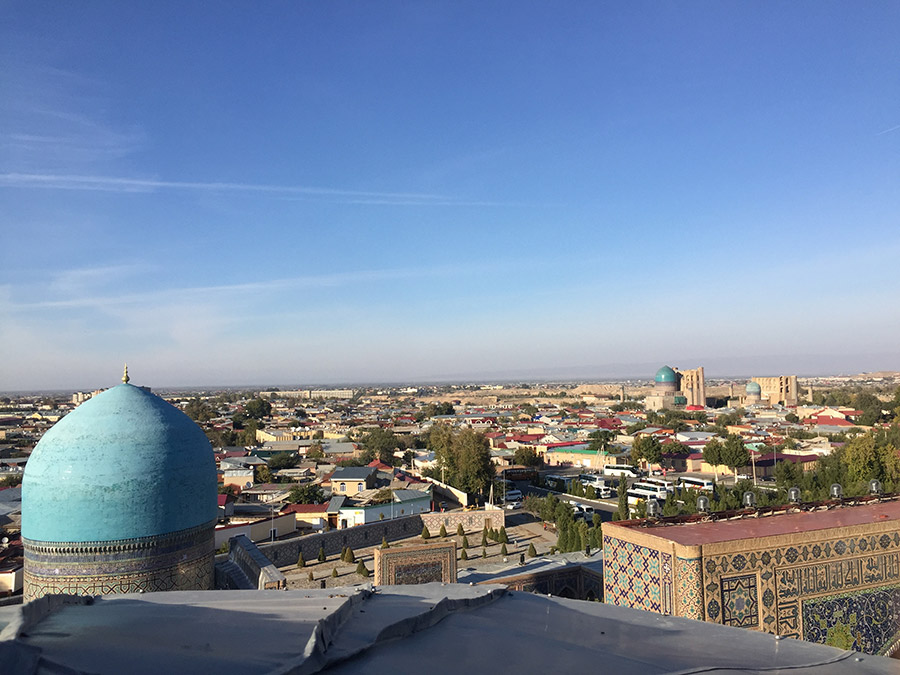
I made my way back down the steps and wandered around the top level of the balconies surrounding the courtyard.
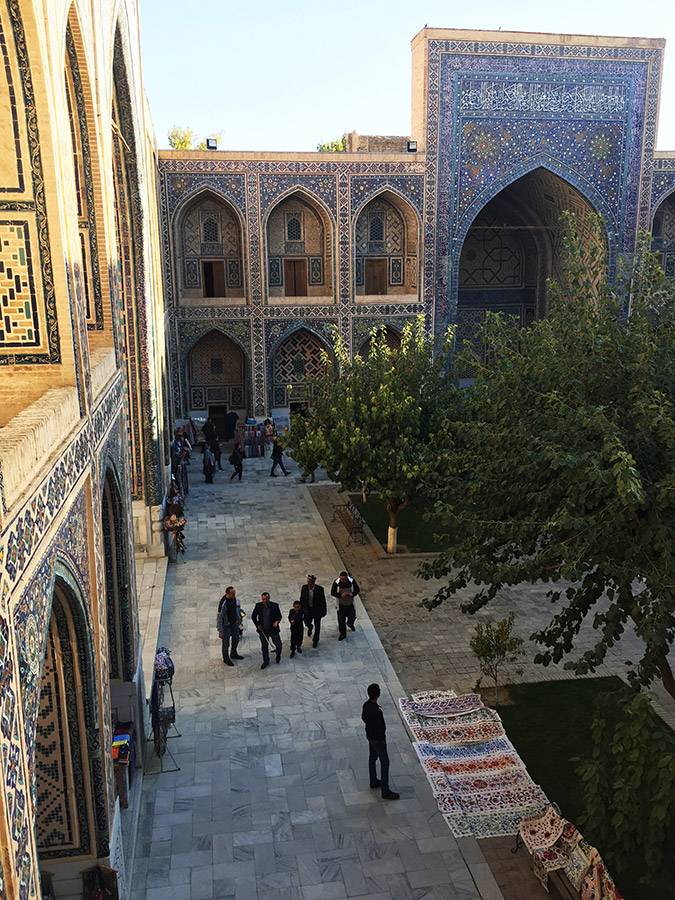
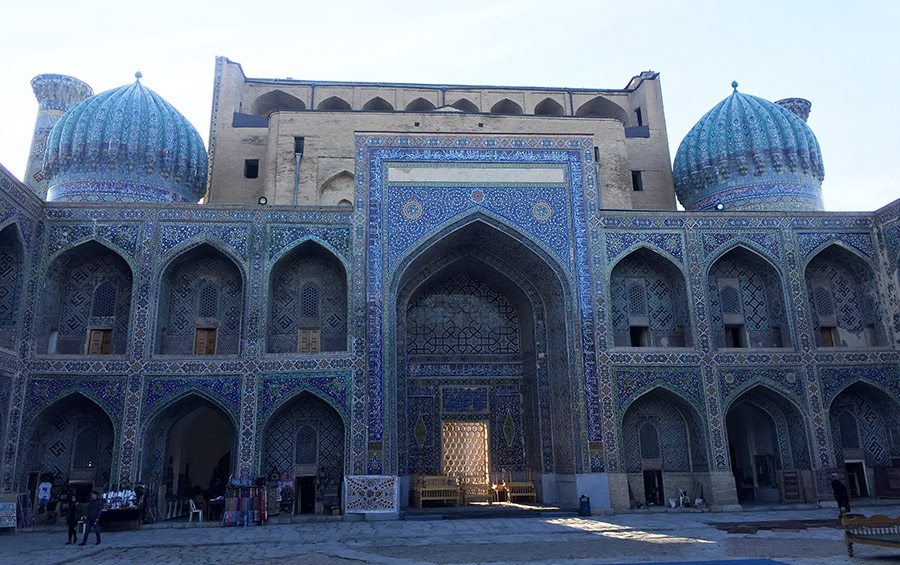
Reaching the ground again, I looked up at the minaret from below and wondered if I’d have climbed it if I had noticed how badly it was leaning beforehand. Probably.
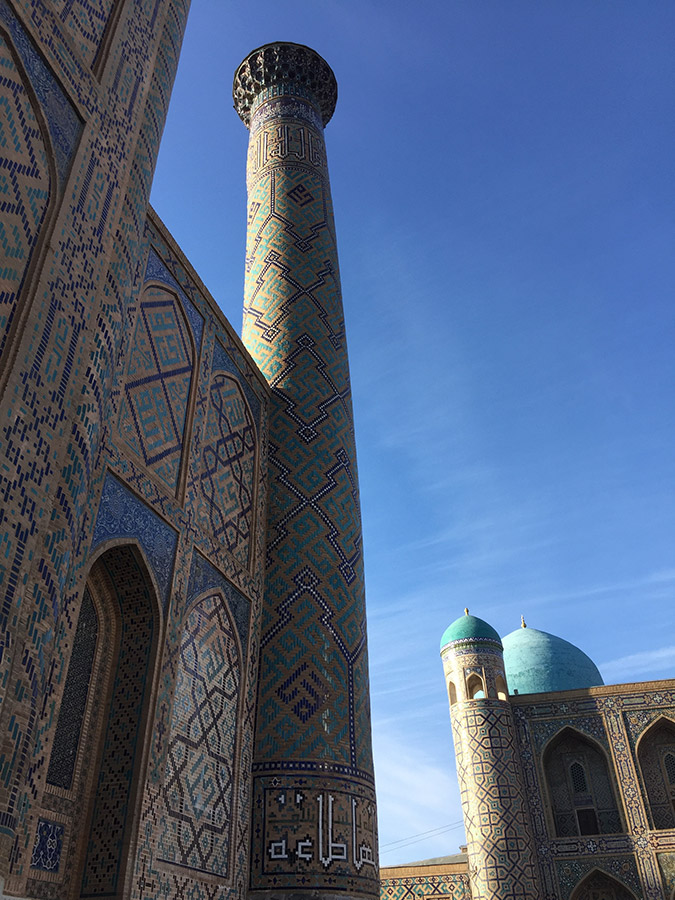
Nearby, the Tilla Kori Madrassah featured the most impressive domed ceiling of any building I saw in all of Central Asia, which is saying a lot.
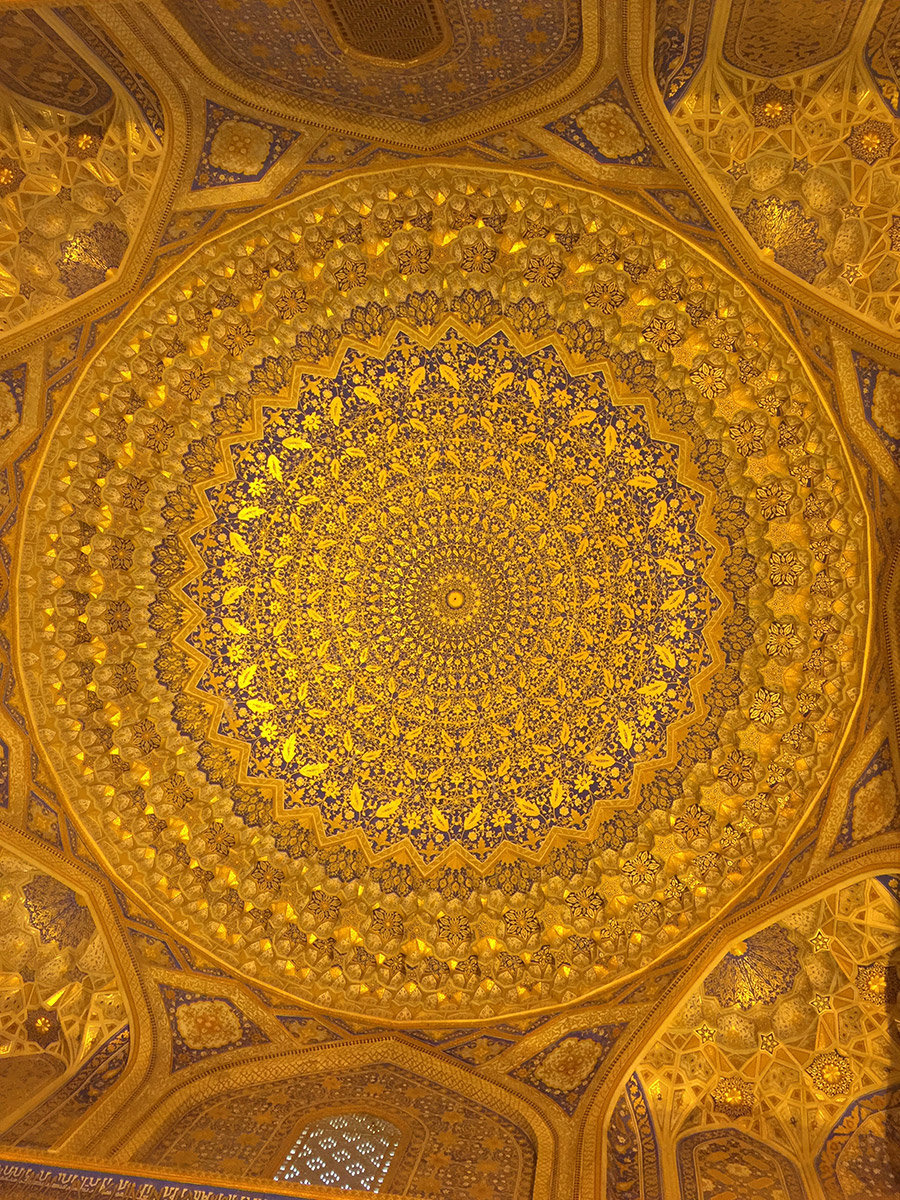
I stared up at the beautiful patterns on the inside of the gold dome. Initricate rings radiated out from the center, and as I gazed up into them, I felt myself moving upward, like I was walking up a staircase through the heavens and into the heart of the sun. The rings shifted outward around me like I was walking through a tunnel, and-
“Excuse me? Photo?”
Some random Uzbek girl wanted a photo with me. I posed with her as her friends giggled.
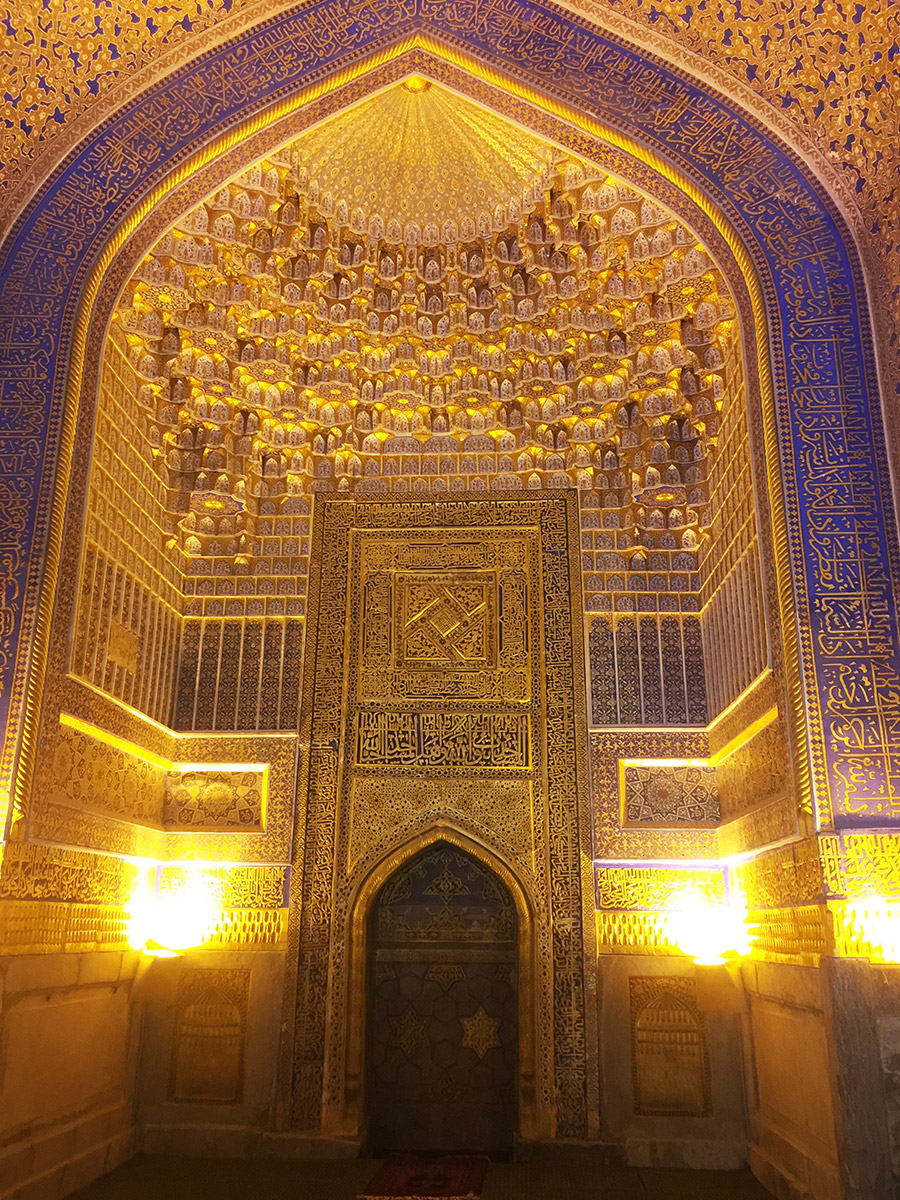
Seeing as how we were in his hometown of Summer Camp Samarkand, Tim knew all the local secrets and the best places to take us. In spite of this, he still took us to a restaurant called Tumor for dinner.
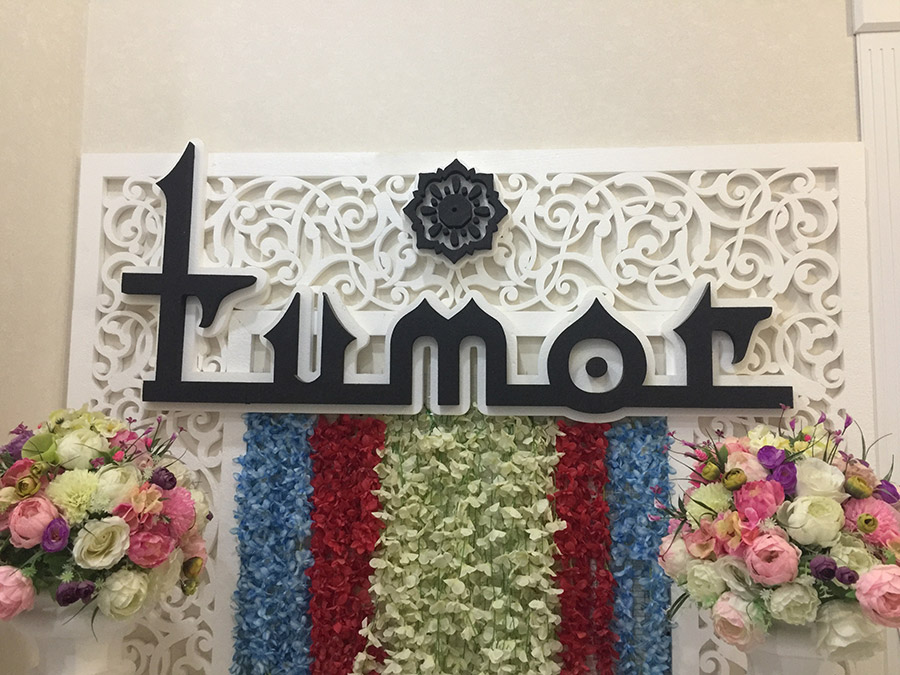
You are so weird Timor.
Just for shits, we took an overnight train from Samarkand to Termez. According to my phone this was only about 180 miles and could have been driven in the time we spent in the VIP lounge waiting to board the train, but Google might be underestimating the extent to which Uzbekistan’s roads make Edward James Olmos’ face look as smooth as a baby’s butt.
I’d never taken a sleeper train before, so this was a fun adventure. The fact that it was a former Soviet sleeper train made it all the better.
To size the sleeper cars, the designers had clearly mapped out how much air space could be occupied by a single fart and then crammed four bunks into that exact space. The quarters were tight and it was a good time to like the people you were traveling with. Thankfully for me, I liked both Gary and Amit quite a lot and thankfully for them I’d recently stopped spending every night coughing nonstop like a tubercular Russian grandmother on her death bed. It was a jamming time.

The absolute best thing about the train was the toilet. I think everyone else on the train would agree with this assessment and I’m so confident in this we don’t ever need to ask them. The only way to improve on a metal bathroom that lurches unpredictably from side to side is to make the toilet just a seat over a hole in the floor, the train tracks whizzing by underneath you while you’re, well, whizzing. The only rule of the train was that you couldn’t use the toilet while the train was stopped at the station, because they prefer to distribute the shit-smeared tracks more evenly across the Uzbek landscape.
Want to burst in on a sleeper car full of Uzbek people you’ve never seen before and exclaim loudly “You’re not my friends!”? No problem. Just don’t poop in front of the station, you animal.
The rocking motion of the train cradles you to sleep quite nicely, unless you’re Gary and you didn’t realize there’s a bar under your mattress that folds up to keep you from rolling out of bed and instead you sleep right on the bar all night. Being Canadian, I think Gary was just too polite to fold up the bar.
As we cruised through the streets of Termez, I was fascinated by the oddball assortment of shops and restaurants. iFood? ASL Burger? That can’t mean American Sign Language Burger. I kind of hope that means American Sign Language Burger.
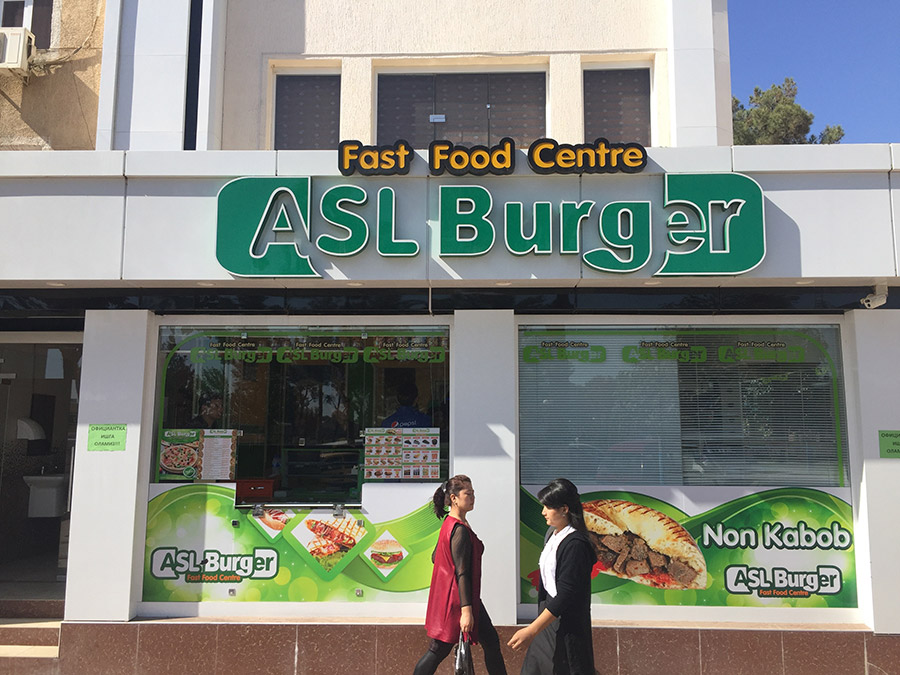
But the thing that blew my hair back was the McDonald’s. There’s no way there’s a McDonald’s in Termez, Uzbekistan, and yet there it is, a restaurant with the golden arches and the familiar McDonald’s logo. What the hell? I have to know what this is.
I speed-walked through the museum we were actually there to visit and took off up the street toward the McDonald’s. How far had our bus driven since we passed that thing? Did I have enough time to get there and back before our bus left the museum?
As I walked briskly up the street, I began to notice the curious looks from the locals. Yeah, I definitely stand out here. This is not a heavily touristed region. I smiled and nodded at people as I went by.
Before long this morphed into people wanting to stop and chat. How’s it going? Yep, I am from America. People were thrilled by this. Before long I was attracting more and more people and was exchanging phone numbers with people and fielding their questions about which colleges they should go to when they get to America.
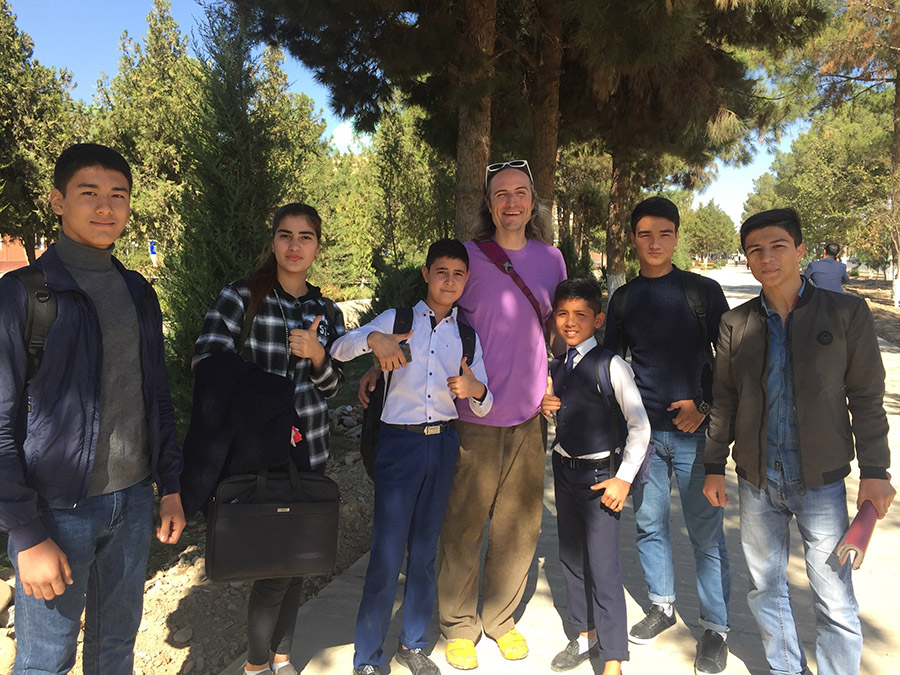
Gary from my tour group showed up out of nowhere. Gary had an incredible talent for disappearing into the local scene like a fantastic spy going native and emerging with a dinner invite or an Uzbek wife.
Shit, I’m not getting to the McDonald’s. That’s okay, this is pretty amazing.
Gary and I made it back to the bus, which took us to our restaurant for lunch. Like all the restaurants in Uzbekistan, the lunch was bullshit for vegans, so I ditched and set off for McDonald’s again. This time I made it.
MakBurger?
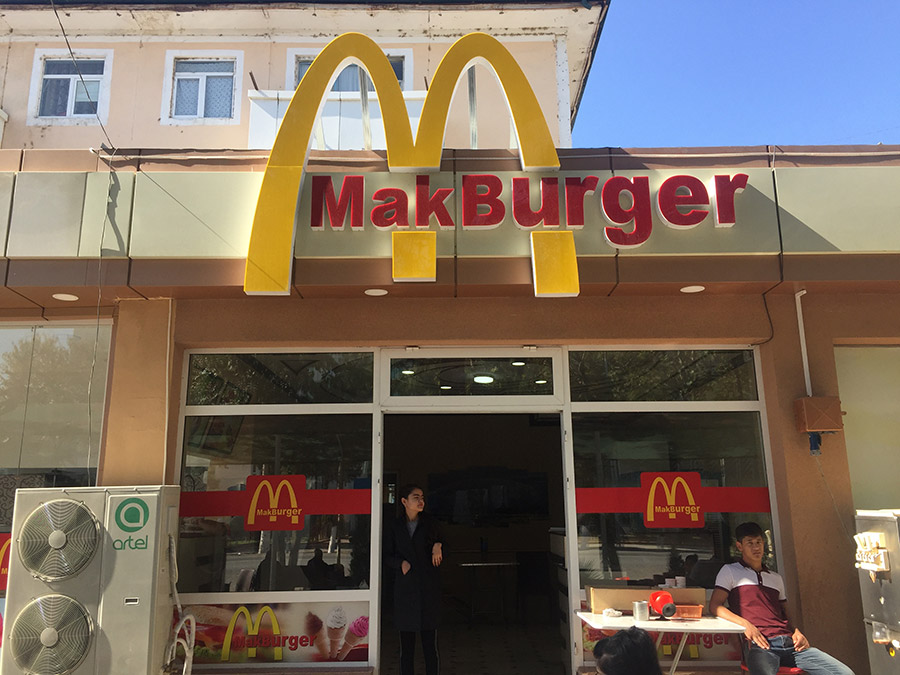
This is incredible. I went inside and ordered some French fries.
The fries took a half an hour because Uzbekistan doesn’t understand the fast aspect of fast food, but that’s okay. It gave me time to be introduced to everyone in the restaurant, including the boxing champion of Termez:
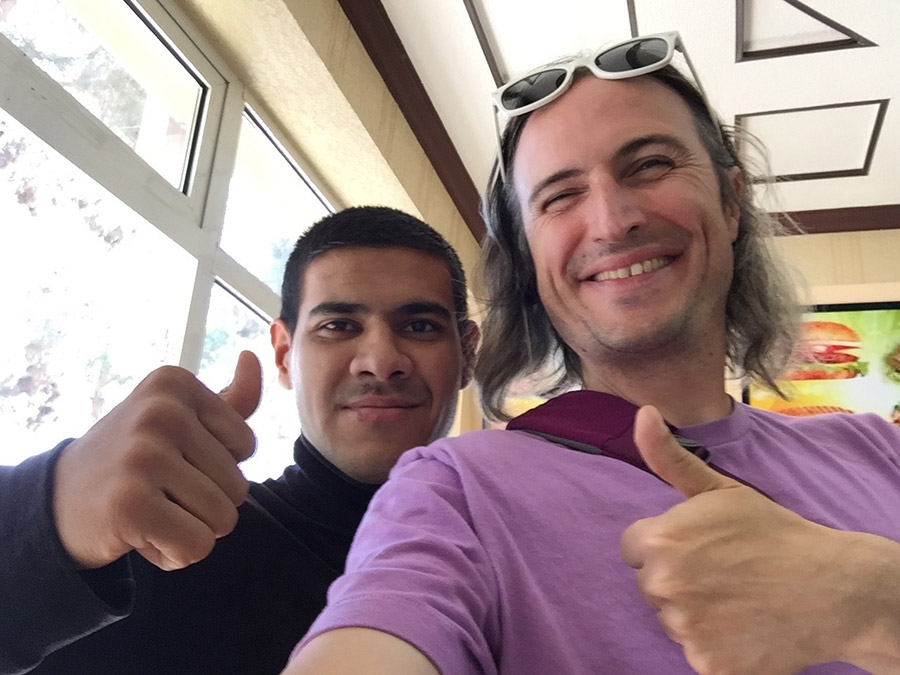
The boxing champ and the owner of the restaurant wanted to know everything I could tell them about America and to take photos of themselves wearing my sunglasses. I did my best to clear up their confusion about the casinos in Los Angeles (“That’s Las Vegas.” “Ah yes! LAS VEGAS!”).
The fries were actually hard to find on the menu, they were buried under a bizarre mix of kebabs and sausages. I loved the uniforms the employees were wearing. I wasn’t sure who this restaurant was supposed to attract, beyond confused American tourists, but it was working.
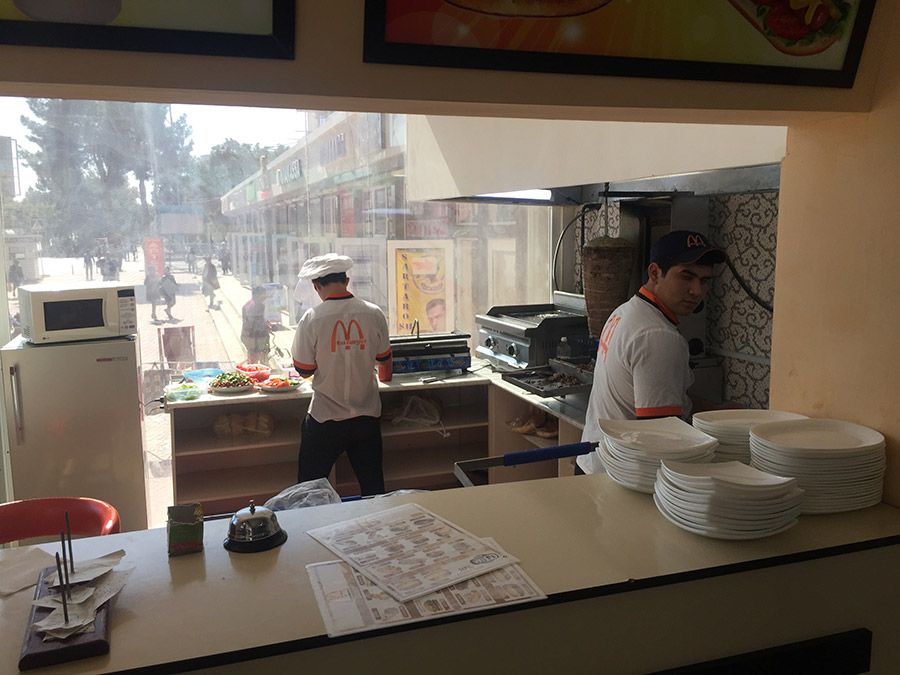
Back at the official lunch restaurant, everyone had just noticed I was gone.
“Where did you go? You met who? Wow, you don’t just go for a walk!”
Erik from Norway was waiting out on the front steps, Uzbek processed meat having already kicked his ass earlier in the trip.
From there we made our way to the Al Hakim At-Termizi Mausoleum. A procession of brides and grooms glided down the beautifully manicured paths toward the mausoleum building.
Inside, the rise in vibration was palpable as soon as I entered the building. Wow. A man sitting on a bench inside sang a beautiful Sufi prayer that reverberated across the ornate ceiling above us, while a woman and her two children knelt in the corner by Al-Tirmidhi’s tomb, chanting fervently.
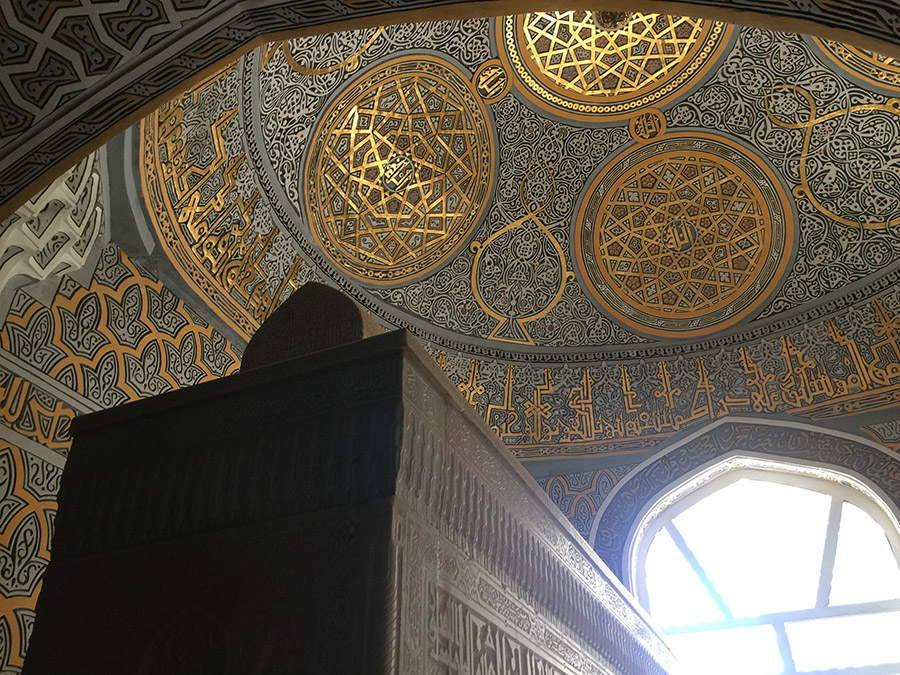
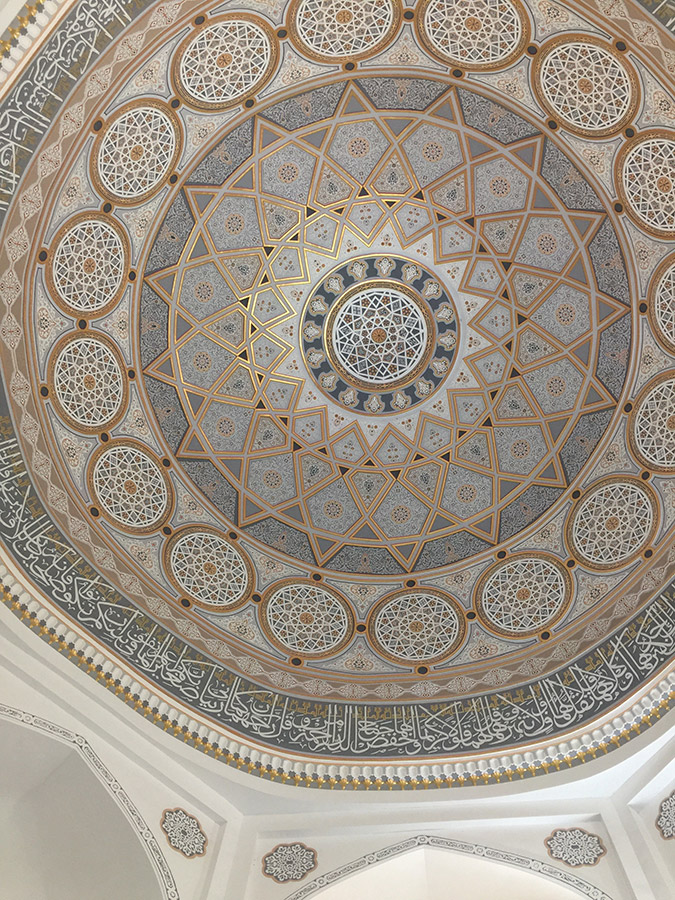
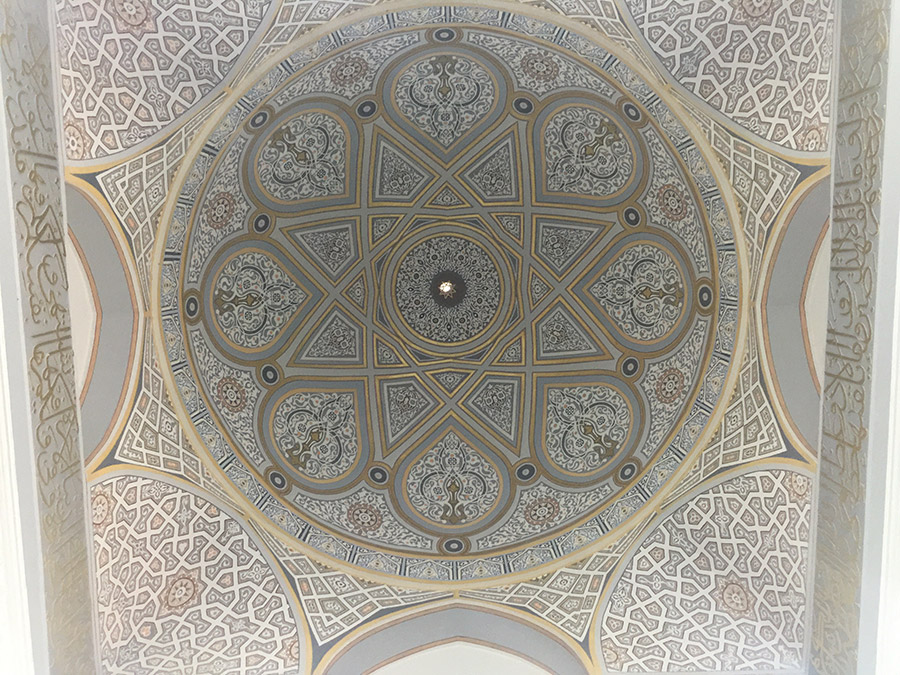
The brides and grooms cycled through, staying for a few minutes each. I sat and soaked up the vibe for a long while as the man on the bench continued to sing. So few sacred spaces hold a vibration like this, and it made me think of the power of human intention. We think of spiritual places as being very significant, but in my experience, people are far more powerful than places. Enough tourists mindlessly tromping through any space will render the vibration very ordinary in no time. It takes a dedicated and conscious intent to hold a special energy in a place, like what the singing man and the chanting woman were doing in here. I deeply enjoyed tuning into the feeling of this space, after days on end of being out in the chaotic energy jumble of the world.
Outside, I found our group and Tim led us over to a set of stairs leading down into a hole in the ground. I waited until I was the last one down the stairs, which led to a small cave.
Tim explained that this cave was a place of prayer, and the bigger the thing was that you were praying for, the more days you had to spend down in this hole praying for it.
We proceeded in a line down into the cave, and everyone did a quick loop, remarking on how small it was, before heading immediately back out, up the stairs into the sunlight. I waited until everyone else was out and knelt down on the stone floor.
Closing my eyes and tuning into the space, I could feel the energy of the tourists who passed through, like a layer of paint on the rock walls. But penetrating through this layer, deeper into the rock I could feel an immense deep stillness. Ahhh, this is what people were doing down here, ages ago. They were meditating on that stillness, staying in it for days on end. I projected my mind into that space, feeling the rock spread out in all directions. It felt as if I was floating in a vast void, a peaceful expanse where no disturbance was possible. Wow.
After a few minutes I regretfully headed back up the stairs into the daylight. As I left, I became aware that I was holding the specific vibration of that space in my head, like the cave existed inside me.
Francine and I passed several more of these holes on our way out of the complex, and I wished I could climb down into each one. As we returned to the bus, I realized I was still tuned into the cave and it was a place I could hold onto inside me and return to energetically at will. I returned to that space several times throughout the rest of the day, feeling my awareness rising and expanding each time I did.
As we drove away, I reflected on all those holes in the ground, and the remorse I felt at not having time to explore the rest of them. What was this all about? I didn’t even know this was here, that this was anything we were going to see on the trip, and yet now it seemed so familiar.
I flashed back to something that happened shortly before my spiritual awakening when I was 27. I was at a low point in my life and was struggling with how to cope with what I was feeling. I hadn’t discovered meditation yet; all I really knew how to do was yoga. So I was doing yoga every day and increasingly spending more time in various poses, sort of a proto-meditation. One day when I was doing this I received a sudden, very intense flash. I saw myself sitting in the same position at the bottom of a hole in the ground. I looked up and saw the blue sky. I knew I had been down there for days and it was some kind of spiritual practice. But I didn’t have any context to understand this memory then, who sits in a hole in the ground?
Huh. Sufis in Uzbekistan did. Was I here, doing this hundreds of years ago? When I sat down to write this blog, I looked up the names of the various places we visited, and when I pulled up this mausoleum I read about who was buried there. Al-Hakim al-Tirmidhi. Huh. He was one of the founders of the Sufi faith. And he was the founder of the dervish order.
Wow.
So that means, if I had been a dervish back then, I probably would have visited this place. Did I meditate down in that very same cave? Damn. Life is crazy.
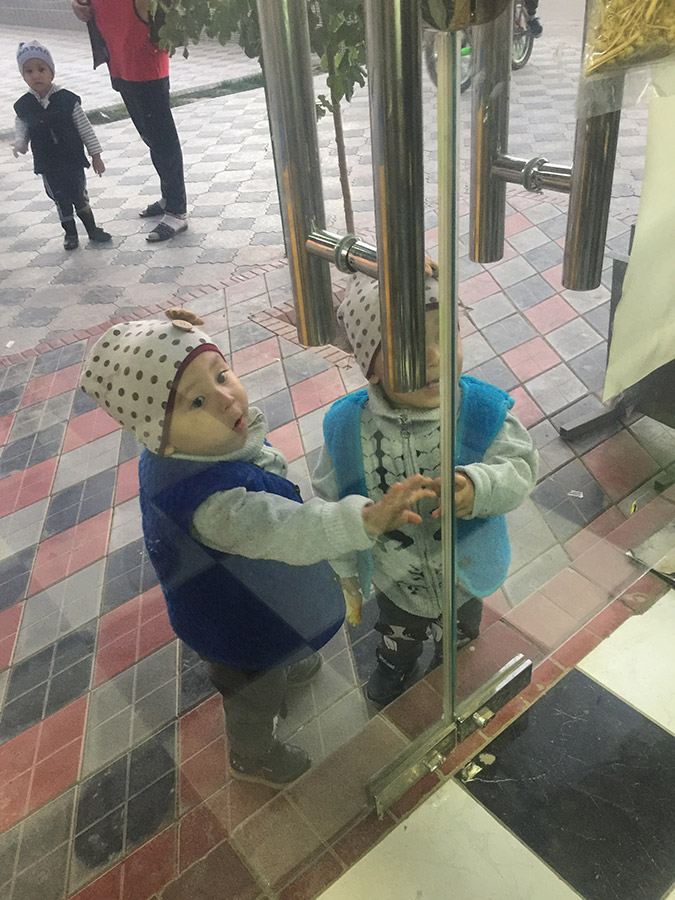
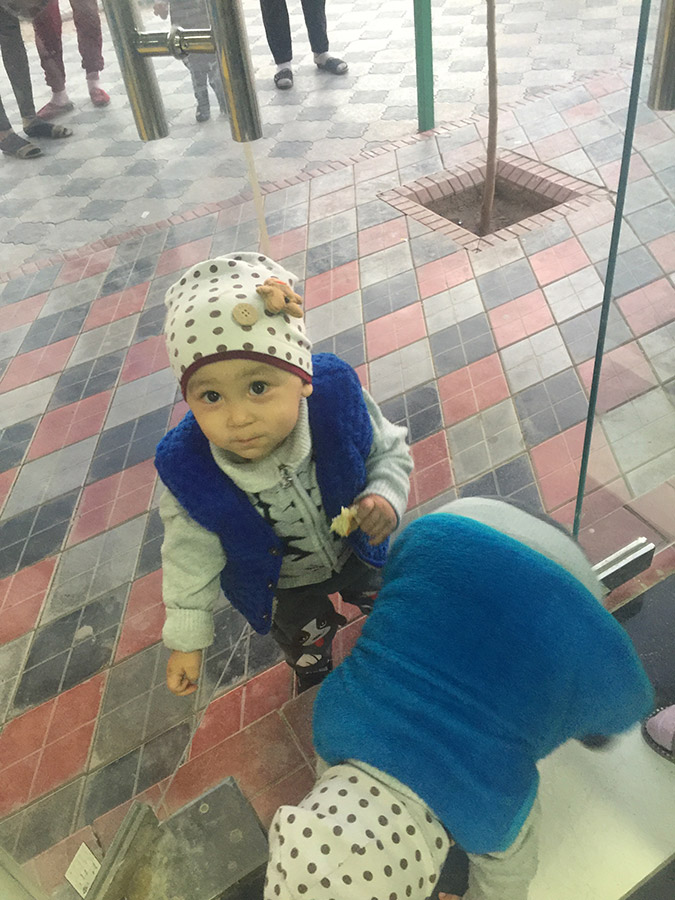
We visited an archeological dig site excavating some ancient Buddhist ruins very near to the border with Afghanistan. Inside one cave was an awesome bat:

Francine was so not into this tiny bat that she flinched and jumped back two feet when I showed her the photo I took of it. The photo.
Tim proceeded to tell us his story of Buddhism that was so confusing it converted several of the Buddhists in our group to atheism.
From the Buddhist ruins it was a short walk to the hilltop where you could see across the river into Afghanistan.
All of us that morning: “Hey Tim, will we be able to see into Afghanistan from the border?”
Tim: “Yes.”
Us: “Cool!”
Tim: “No, not cool! It’s Afghanistan!”
We weren’t supposed to take any photos of Afghanistan from across the border, the reason for this was unclear but soldiers in hilarious hats had made this clear to Tim and him, us, sort of. The only people in our group who didn’t badly want to take photos of Afghanistan were the few who had already been there, so the photos evolved from discreet hip snapshots when Tim was looking the other way to us just wandering over the hill to where Tim couldn’t see us and taking a metric fuckton of photos of Afghanistan.

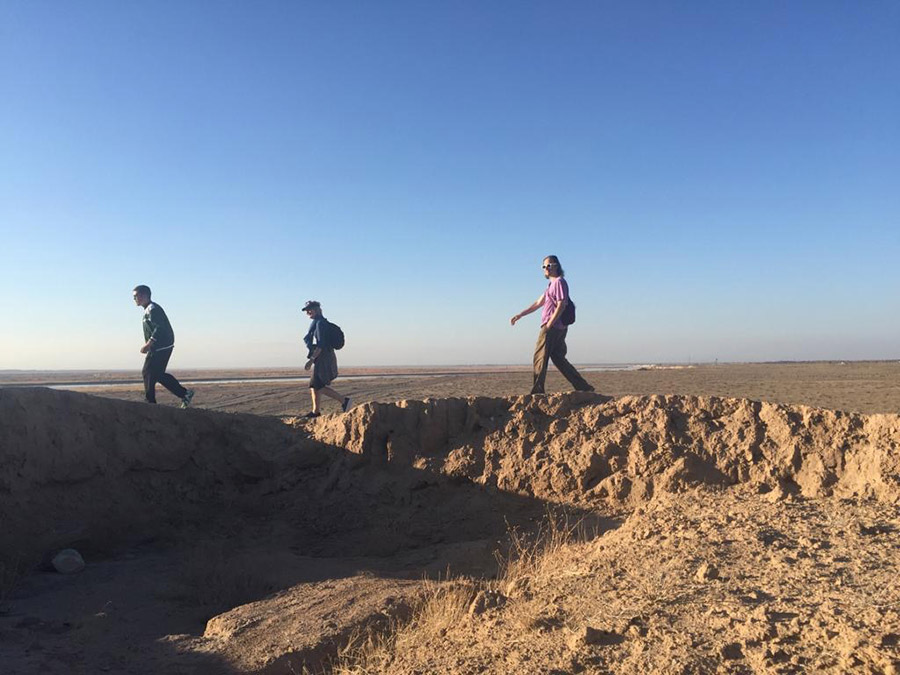
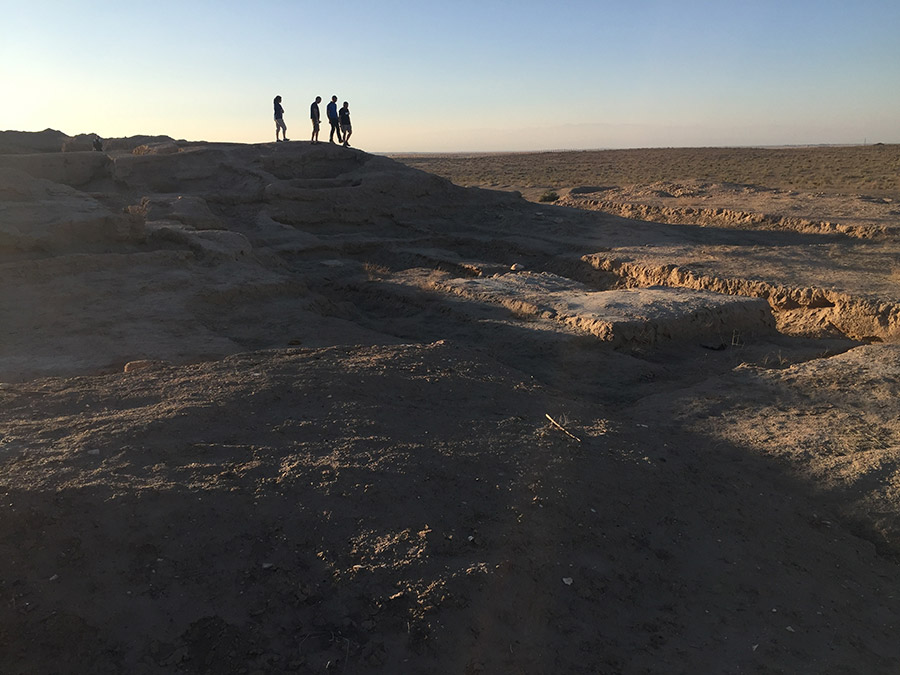
Erik had already been to Afghanistan, following the admirable strategy of visiting the most dangerous ‘stans first while you’re still young enough to run way from trouble. He told the harrowing story of the one guy in his tour group who absolutely did not get the concept that they were in an extremely dangerous country and was constantly putting them in mortal peril by doing every last thing you should never do in Afghanistan if you have designs on leaving Afghanistan alive.
Keeping in mind this is a country that even adventure tour companies won’t take you to unless you’ve traveled with them before and they know you’re not a dipshit. When you get there, they dress you in local clothes so you don’t stand out like a turd in the punchbowl and get everyone killed.
You definitely do not want to take photos of women in burqas in Afghanistan. This is beyond rude and being beyond rude in Afghanistan is bad for your health. But even if you can’t grasp that concept, you should be able to wrap your head around not taking photos of anyone holding a machine gun. Soldiers and other gun-toting Afghans are wary of being ambushed by assassins posing as photographers, so odds are they’ll just shoot anyone who approaches them with a camera. This guy just kept doing it anyway, when he wasn’t busy taking photos of women in burqas.
Eventually Erik decided he didn’t want to die along with this guy, so he left the tour early. The rest of his tour group mutinied and refused to ride in a car with the clueless guy, lest they end up as collateral damage when he was inevitably killed. So he was quarantined in his own car with his own local guide. Toward the end of the tour, he was taking photos of local women on the street when he found himself surrounded by irate villagers, demanding his bodily harm. The local guide assigned to his car ran over to talk them out of it, and for his trouble the entire town beat the snot out of the guide. The clueless guy somehow emerged unscathed. Shrug emoji.
The desert in that area around the border was littered with bullets, exploded tank rounds, and some bizarre shit straight out of Tatooine:
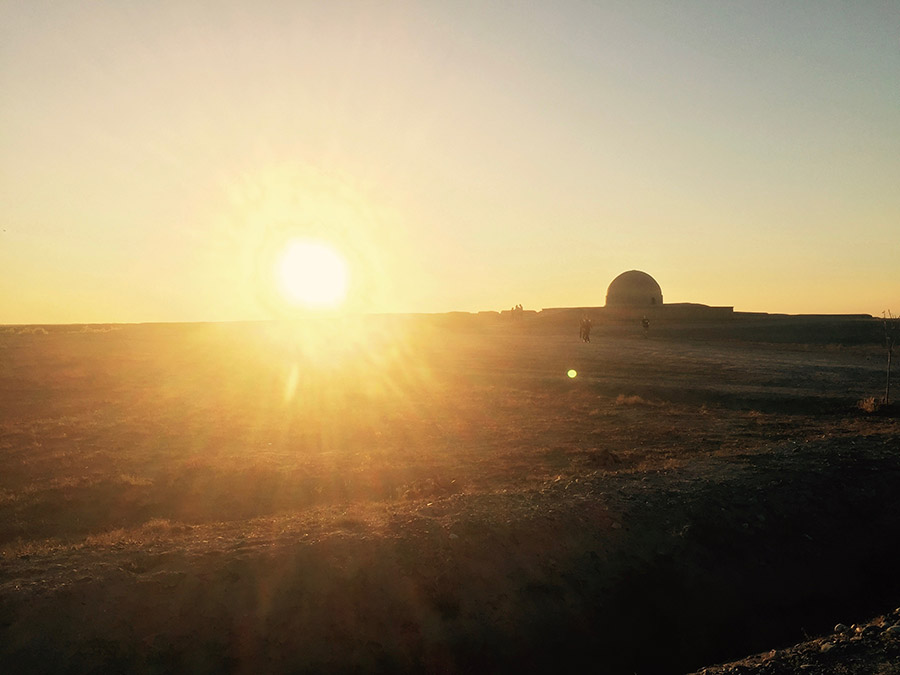
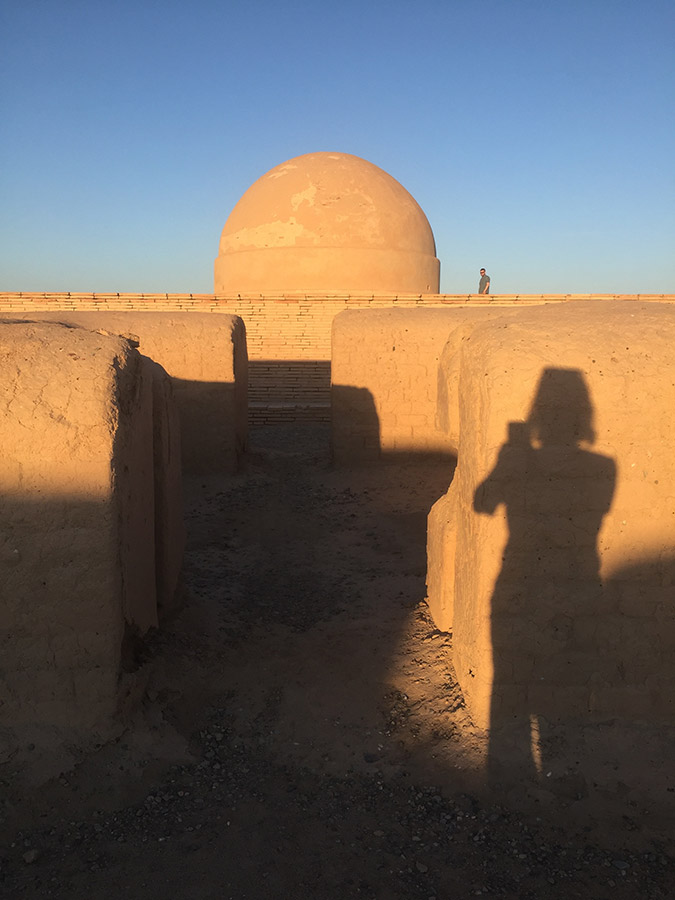
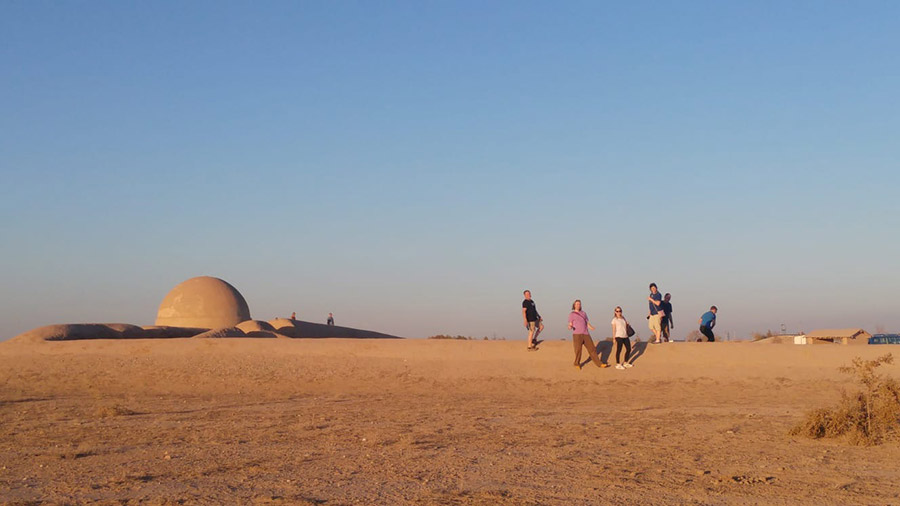
Random memories string together, unattached to a specific place, from rambling across Uzbekistan...
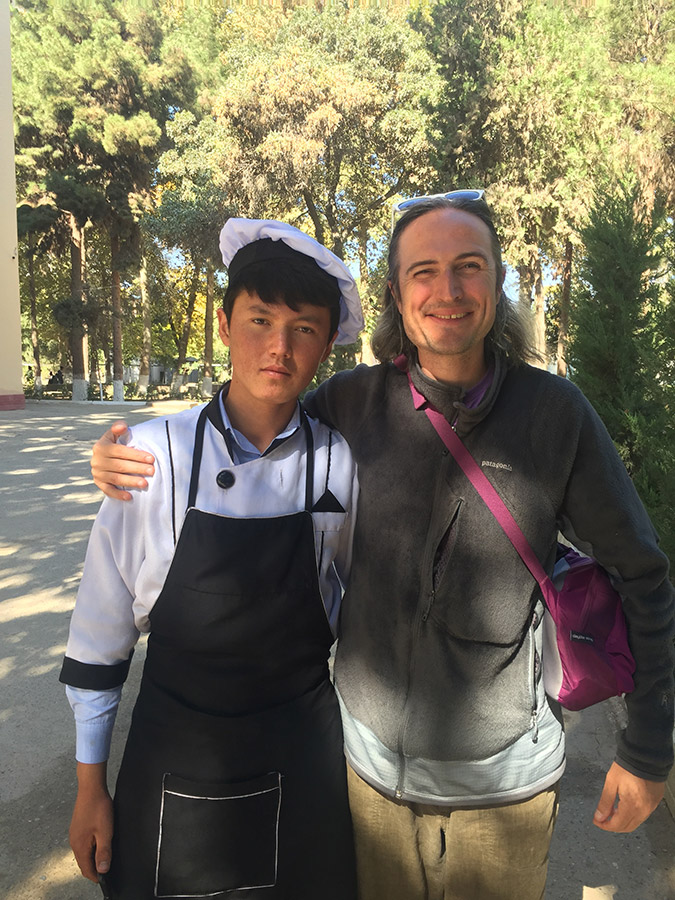
Sitting at lunch in a family’s house while the theme from The Godfather played for no conceivable reason whatsoever. Are we all about to die? What will they play next? Feelings. I can dig it.
The random bullshit you do on tours. Watching paper being made from mulberry trees. Sitting through a horrifying puppet show for the shortest physical time possible before escaping out the door into the puppet-free air outside.
Puzzling at all the signs everywhere that said Go’sht. Go shit? It turns out that’s Uzbek for meat. Huh. Either way I’m gonna pass.
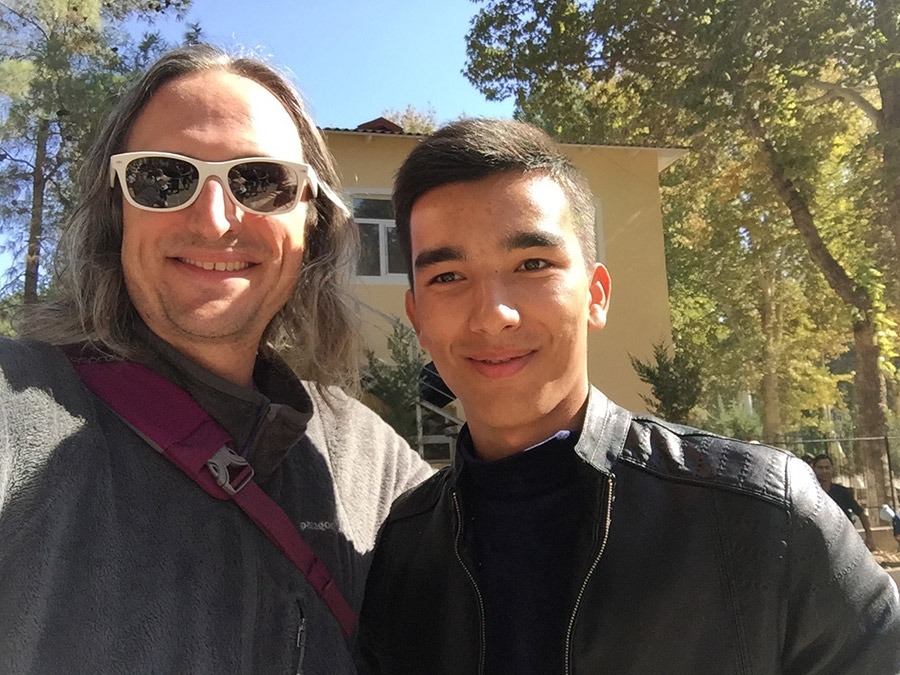
Speaking of, most of the ‘stans favored a bizarre kind of crimped toilet paper that is most similar to the rolls of streamers you’d buy at the party store to decorate the house for when Uncle Joey gets out of prison. Should toilet paper be stretchy? Who am I to say.
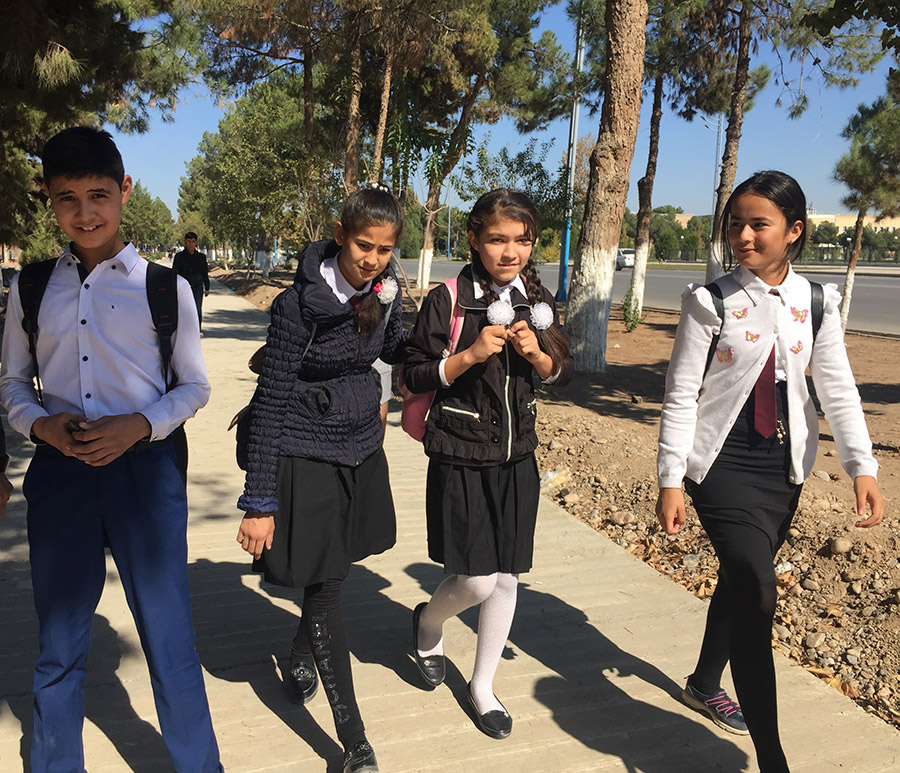
One of my favorite details of Uzbekistan were the cardboard cut-outs of police cars perched by the sides of the roads. Was this supposed to fool people into slowing down? The cut-outs had cartoon drawings of police cars on them, not exactly convincing. Is this like a scarecrow for speeders?
I asked Timor about these and he explained that they don’t fool the locals, but Uzbekistan gets the most tourists of any of the ‘stans and these cutouts were to fool the tourists into slowing down. Some of the more elaborate cutouts were even furnished with flashing red and blue police car lights. Later we noticed cardboard cutouts of a woman and child at crosswalks.
Spotting the adorable “Beeline” shops everywhere that I imagine are Uzbekistan’s big cell service provider.
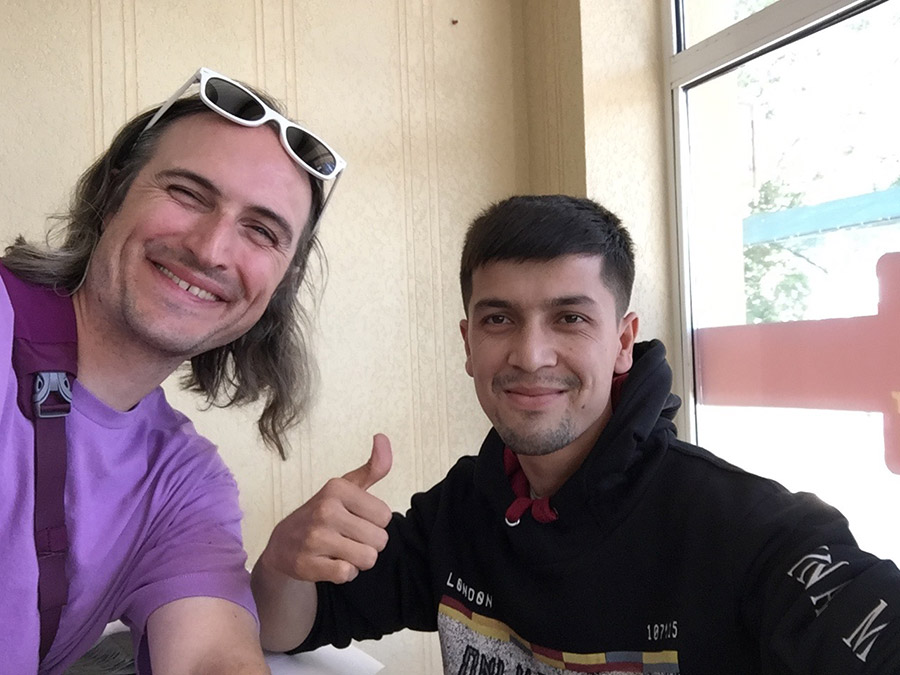
Our bus passing an ancient and tiny Soviet car that had two huge wheelbarrows tied precariously on top, the Uzbek family inside all in traditional dress, looking up at us like we were aliens visiting from a different century.
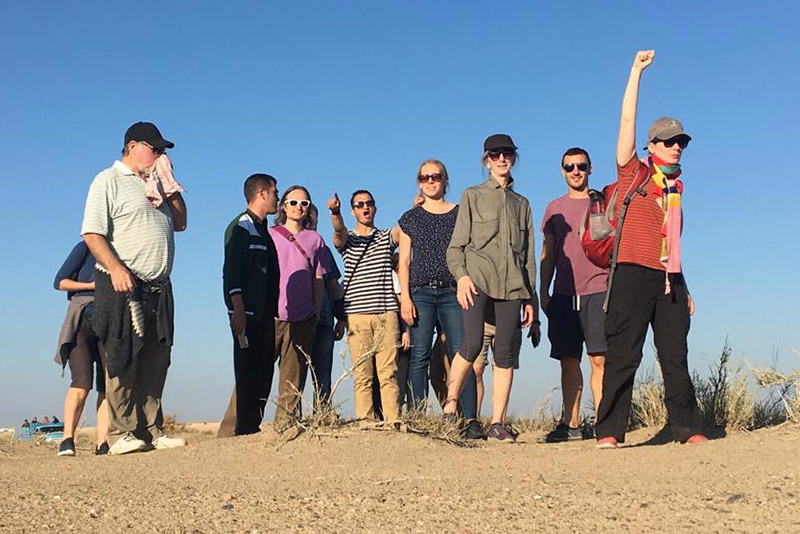
Locking eyes from the bus with a child who is walking a cow up the highway, as I’m typing on my laptop to share my thoughts with people around the world through a massive network of interfaced computers.
Can either of us really understand what the other one is doing?